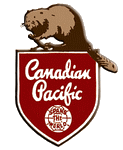 CANADIAN
PACIFIC
CANADIAN
PACIFIC
Donated by Canadian Pacific Railway, MLW C-424 4237 and M630 4563 pose in St Constant QC at the CRHA Exporail Museum on September 11th, 2015. Francois Jolin took this photo at the restored Barrington Station.

On September 17th, 2015, Delaware & Hudson GP38-2 7303 was shot by Sam Meehan as it sat in Taylor, PA on the last day of the D&H (CP) in Pennsylvania. Earlier this year, CP sold the southern part of the D&H to Norfolk Southern Corp.
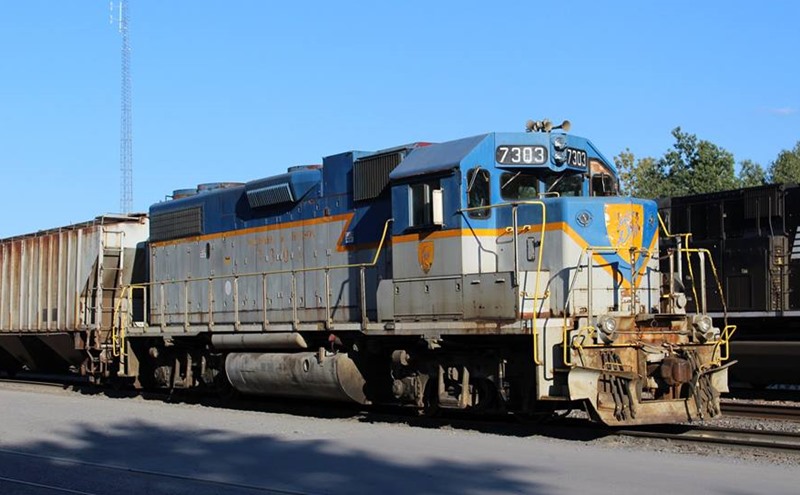
CP LOCOMOTIVES STATUS:
All 7 remaining CP SD40-2F locomotives on the CP Roster are stored, (9001, 9003, 9006-9009, 9015). All other Red Barns are retired.
CP SD40-2F 9004, 9010, 9011, 9014, 9017 and 9020-9024 were sold to Central Maine & Quebec (CMQ), in September, the CP road numbers retained.
At sunrise at Farnham, QC on October 1st, 2015, Francois Jolin clicked Central Maine & Quebec train 810 with LTEX GP35u 2558 and 2525 passing ex-Canadian Pacific SD40-2F 9022, the first of ten "Red Barn's" acquired by the Central Maine & Quebec (CMQ).
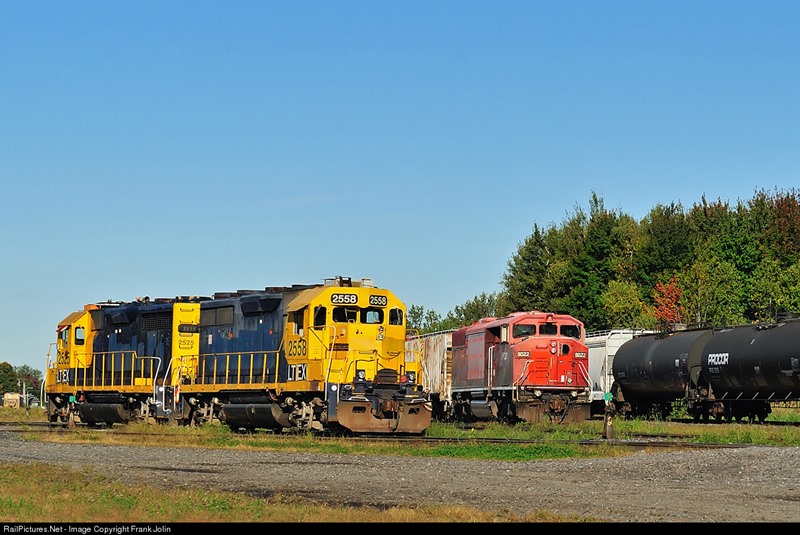

With the downturn in traffic, CP has tied up and stored many of the GE AC4400CW units in the CP 9500-series.
As well, the Canadian Pacific SD9043MAC fleet is stored, including the last three that were in service CP 9108, 9142, and 9157.
Some CP GEVO's continue to be used on the BNSF (and UP) for HPH. In the early morning sun in mid-September in Stockton, CA George Manley caught a BNSF northbound grain train with CP ES44AC 8858 and CP 8788 as the power have just rounded the curve at Keddie Jct. and are going onto UP rails for the run north.
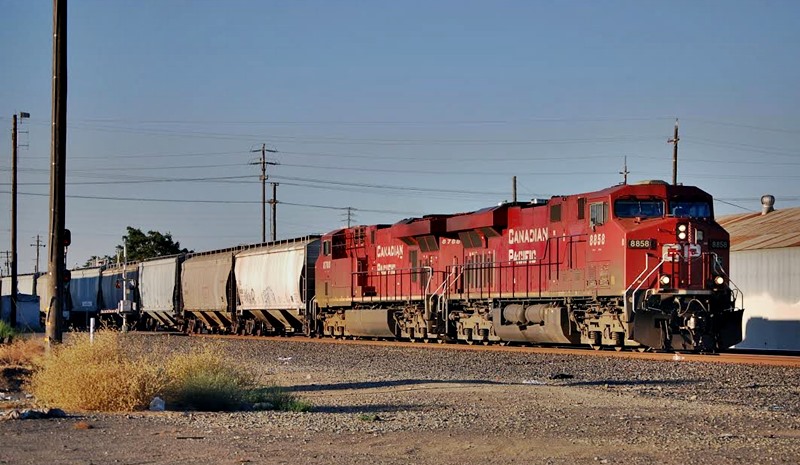
Shawn Heller caught BNSF train H-VAWBAR departing Vancouver, WA with the BNSF 6677 and 4567 up front, plus two DPUs in back.

Here are the DPUs on the rear of H-VAWBAR, BNSF 4782 and again, CP ES44AC 8858.
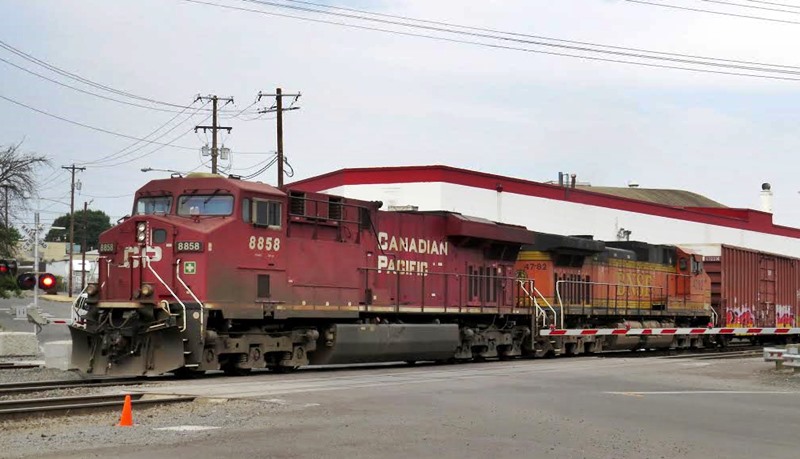
CP CNG Program:
CNG test unit CP SD40-2 6061, and CP CNG Tender 527371 are being sent to the AAR Test Track at Avondale, Colorado. CP has modified and repainted CP SD40-2 6061 for LNG testing. Looking similar to CN's fuel Tenders, the LNG equipment and Tender has been fitted into a modified CP 53' well car now renumbered CP 527371). Compressed Natural Gas (CNG), is stored in high pressure (3,600 to 5,000 psi) cylinders, and does not require vaporization to convert to GNG. CNG is unlike using an LNG locomotive with an LNG tender. LNG means "Liquefied Natural Gas", which is a -260 Deg F liquid fuel that is stored in a cryogenic container then vaporized into GNG (Gaseous Natural Gas - a new RR specific mechanical term). The straight natural gas or dual fuel (diesel + NG) engine uses the gaseous form of natural gas (GNG), so it does not care whether the fuel is stored as LNG or CNG. The only natural gas locomotive vendor that has specifically stated they must use LNG is the EMD-Westport HPDI project. And this is primarily because the High Pressure Direct Injection (HPDI) system on the engine requires a constant 5,000 psi, which can be supplied from vaporized LNG, but would be more difficult (though not impossible) to supply from a CNG system where the pressure of the GNG continues to decrease as the volume of gas in the storage cylinders decreases. Because the locomotives in test today use GNG, the railroads have gotten away from using the term "LNG locomotives" in favour of simply calling them natural gas locomotives. The press, however, still is caught up in the misnomer "LNG locomotive" for any locomotive that can run on natural gas. While saying that the current BNSF GE and EMD test units are LNG locomotives may be acceptable to some degree (since they are using LNG fuel tenders), there is no physical change needed for these locomotives to utilize a CNG fuel tender. Hence, an LNG locomotive is also a CNG locomotive, and thus the move to simply call them natural gas or NG locomotives. In the case of CP 6061 the term LNG is not appropriate because there is no LNG anywhere on the locomotive or tender which has a separate 20' container of CNG and 20 foot generator only.
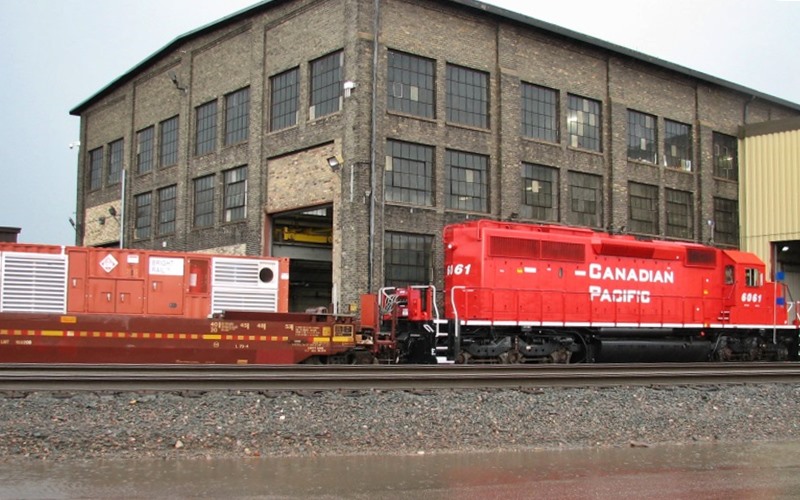
CP Locomotives Retired, Declared Surplus, Stored or Sold:
In September, CP SD40-2F 9004, 9010, 9011, 9014, 9017 and 9020-9024 were sold to Central Maine & Quebec (CMQ), the CP road numbers retained. The first had arrived on the CMQ as we went to press. The CMQ uses operates over the bankrupt MM&A, nee-CP trackage.

Ex-CP 1605 was sold to Respondek in September 2015 moved from Toronto to Kansas City over CP, then KC to St Louis over Norfolk Southern then TRRA to Port Harbor Railroad.
The lease of CP GP9u 8249 to Gardner Dam terminal expired and in September it moved from the facility to the diesel shop in Moose Jaw and is now in Toronto. She was the last GP9u on the CP roster, and as of September 23rd, has been declared Surplus.
CP 8218 was sold to the Pennsylvania Northeastern RR on August 18, 2015 and was in transit to destination in September.
Fifteen GP9u's were sold to LTEX on June 26, 2015: 1532, 1547, 1555, 1560, 1585, 1590, 1597, 1604, 1633, 1634, 8200, 8220, 8231, 8239 and 8250
The following 30 declared surplus SD40-2 units are at Bombardier Transportation's plant in Sahagun, Mexico to be rebuilt to SD30C-ECO units: CP 5648, 5729, 5742, 5776, 5787, 5793, 5827, 5843, 5844, 5924, 5940, 5944, 5947, 5948, 5963, 5964, 5967, 5981, 5982, 5998, 6004, 6006, 6021, 6026, 6058, 6076, 6078, 6604, 6615 and 6616.
CP LOCOMOTIVE REBUILD PROGRAMS
CPR Tuscan Red and grey FP9A 1401 is still at the RELCO Shop, and receiving a complete refurbishment in Albia, IA. Once modernized, this F-unit will become what some are calling an "F38A-3" which will include an EM2000 computer and its own HEP equipment. The unit will be like a GP38-3, with computer upgrades, all under the shell of an FP9A. Matt Petersen clicked CP FP9A 1401 at RELCO in Iowa on March 13th, 2015.
CP GP38-2 R/C Program:
CP is continuing to install Remote Control (R/C) equipment on 28 of their GP38-2 units, with some currently stored at St-Luc Diesel Shop, waiting to be moved to Cadrail as space becomes available at the Lachine-based loco shop:
These unit numbers were confirmed at Cadrail and have been released with the R/C Modifications, or are now being completed: CP 4400, 4401, 4440, 4441, 4426, 4435, 4436, 4444, 4447, and 4507.
NRE is also contracted for this CP initiative as well. These units are currently confirmed at NRE Silvis, IL for rebuild, repaint and remote control and ZTR installation: 4445, 4434, 4420, and 4443.
One of these CP units now completed at NRE in Silvis, Illinois is CP 4445 shown in late-September.
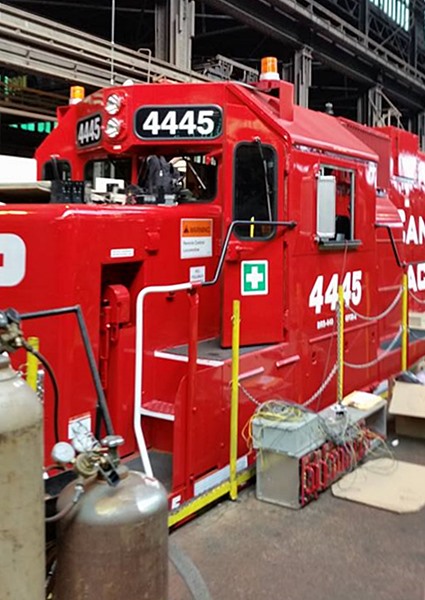
CP GP38-2 Overhaul:
Meanwhile, the previous program of overhauling GP38-2 and GP38AC locomotives to Tier 0+ compliance, and upgrading with AESS (Automatic Engine Start/Stop), and full CP repaint has changed with the new RCL program now paramount. As of September 31st, CP (ex-SOO) GP38-2 4445, 4434, 4420, and 4443 were in various stages of completion. SOO GP40 2066 is also in the shop for a complete overhaul, and has been stripped down to her frame.
Released from NRE (Silvis, IL):
CP 3001, 3005, 3007, 3009, 3010, 3013, 3015, 3116, 3017, 3020, 3023, 3033, 3050, 3058, 3072, 3074, 3075, *3084 (*Script), 3096, 3103, 3116, 3124, 3134,
CP (ex-SOO) 4401, 4403, 4409, 4421, 4426, 4437, 4439, 4444, 4449, and 4451.
CP 7307 (ex-D&H, nee-LV), CP 7308 (ex-STL&H, ex-D&H, nee-LV) 7308, and (ex-D&H, nee-LV).
Released from CADRAIL (Lachine, QC):
CP GP38-2 3026, 3027, 3130, 3053, and 7306.
The contract was completed in 2014.
Released from EMD-Progress Rail (Mayfield, KY):
CP GP38-2 3024, 3025, 3038, 3040, 3041, 3042, 3048, 3057, 3061, 3062, 3066, 3111, 3117, 3126, 3127, 3128, 3129, and 3133.
CP (Ex-SOO) 4414, 4415, 4418, 4424, 4427, 4428, 4436, 4446, 4447, 4450, 4506, 4513, 4514, and 4515. The EMD/Progress Rail overhaul contract was completed in 2013.
SOO SURVIVOR: On September 20th, Dennis Weber caught the CP Yard Switcher with the not yet overhauled SOO GP38-2 4402, at LaCrosse, WI.
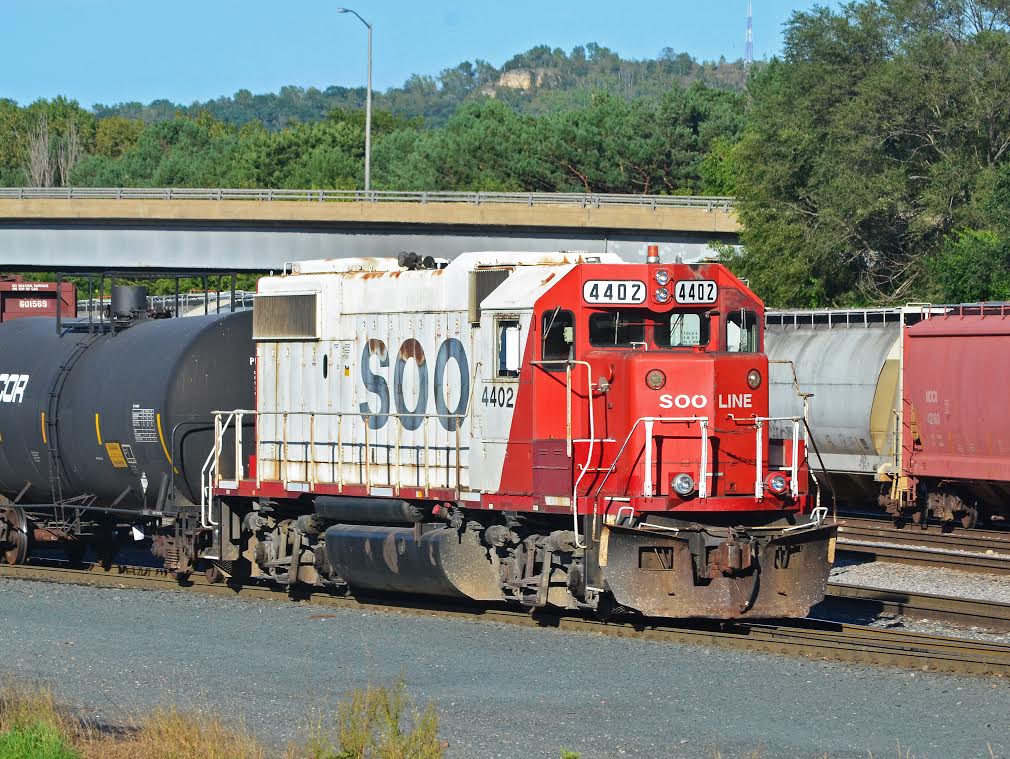
Erik Rasmussen clicked one of the last remaining GP40's wearing ex-Milwaukee "Bandit" paint getting overhauled at NRE in Silvis Illinois on August 21st. After spending several months in NRE's deadline waiting for a turn through the shop for overhaul and repaint, the time has finally come. SOO 2066's frame is being worked on inside the ex-Rock Island shop building at Silvis. The GE in primer at left is CN C40-8W 2191, which was wrecked at Slinger, WI in 2014, She is now completed and repainted CN. This photo taken with permission, while escorted by an NRE employee.
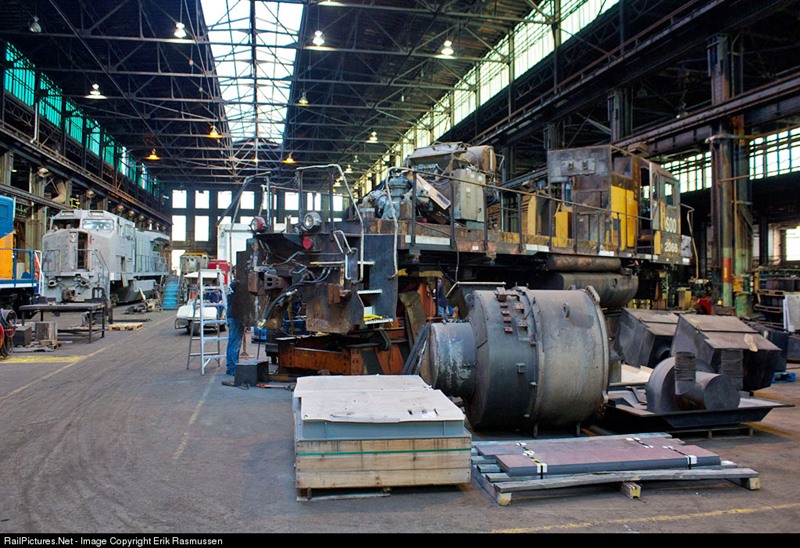
SOO SD60 overhaul - Contract Completed:
CAD Railway Industries (Lachine, QC), completed the former SOO LINE SD60 and SD60M overhaul and repaint contract for the Canadian Pacific Railway in August 2013. The overhauls included Tier 0+ compliance, installation of AESS (Locomotive Automatic Engine Start/Stop) to conserve fuel. All are in Candy Apple Red and renumbered into the CP 6200-series, and each received (PTC) Positive Train Control modifications at the CP St-Luc Diesel Shop. They did not get any cab upgrades however.
CP SD60's and SD60M's released from CAD during 2012 and 2013: CP 6221, 6222, 6223, 6225, 6228, 6229, 6230, 6231, 6232, 6234, 6236, 6238, 6239, 6240, 6241, 6242, 6245, 6243, 6246, 6447, 6248, 6249, 6250, 6251, 6252, 6254, 6255, 6256, 6257, 6258, 6259, 6260, and 6262. All are in service, and equipped as leaders.
SOO 6026, 6027, 6035 and 6044 have been stored serviceable since April 2015, leaving only four SD60 units remaining in service wearing SOO LINE paint: SOO 6024, 6033, 6037, and 6053. Two are in SOO white and two in SOO candy apple red. As well SOO SD60M 6061 is active, and the last one in SOO livery). Catch them while you can!
Alex Sanders clicked CP 646 with one of the remaining SOO SD60s in white paint (SOO 6037), leads a pair of NS units (8416 and 9888) through downtown London on July 20th, 2015.
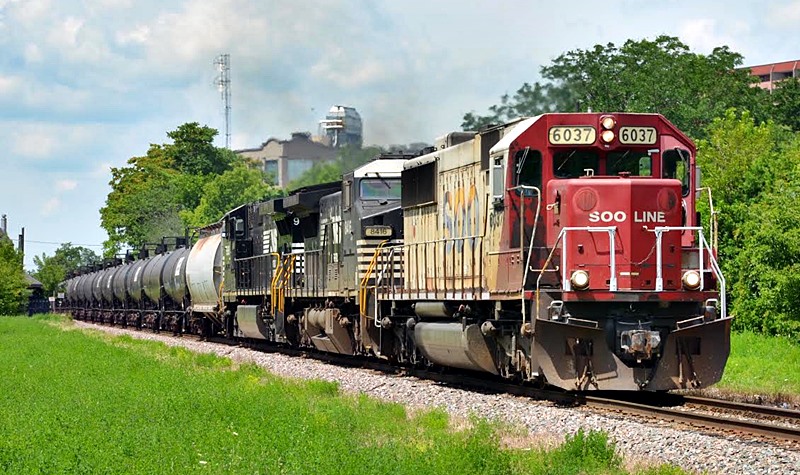
CP SD30C-ECO Latest Order:
Canadian Pacific's latest 30 unit order has 15 units are expected before the end of this year, with the remaining 15 coming in 2016. Unlike the first order that was constructed at EMD/Progress Rail's Mayfield, Ky., plant, this SD30C-ECO's order is being built at Bombardier Transportation's Sahagun, Mexico plant.
These Surplus CP SD40-2's are being used in the program: CP 5648, 5729, 5742, 5776, 5787, 5793, 5827, 5843, 5844, 5924, 5940, 5944, 5947, 5948, 5963, 5964, 5967, 5981, 5982, 5998, 6004, 6006, 6021, 6026, 6058, 6076, 6078, 6604, 6615, and 6616. (Note: Several were substituted and in this updated list above. More changes may take place). These following units are confirmed to be already in Mexico for rebuilding into SD30C-ECO's this year: CP 5648, 5776, 5793, and 5947 with another four as well (numbers unknown).
The first 20 unit order of SD30C-ECO units built at EMD/Progress Rail in Mayfield, KY, was completed back in January 2014. CP 5000-5019, are all in service and in April were reassigned from Shorham Shop in St-Paul, Minnesota, with some now working in British Columbia for crew training.
CP GP20C-ECO All Three Orders Now Completed:
CP's third order for 60 CP GP20C-ECO units (2270-2329) has been completed, with the delivery of the last units CP 2316, 2321, 2328 and 2329 on January 26th, and CP 2287, on January 31st. 2015. These EMD Mucie, IN-built locomotives are brand new, with only the Blomberg trucks, and air compressor salvaged from the retired GP9u's.
The first order of 30 GP20C-ECO units
CP 2200-2229 are assigned to St. Paul, MN.
The second order has the following Canadian assigned units;
CP 2230-2249 are assigned to Alyth Yard, in Calgary, AB.
CP 2250-2269 are assigned to Toronto Yard.
The third order of GP20C-ECO units is now complete: with CP 2270-2329 assigned as follows:
St. Paul, MN: 2270, 2271, 2272, 2273, 2274, 2277, 2278, 2302, 2306, 2324, 2325;
Moose Jaw, SK: 2275, 2276, 2285, 2289, 2294, 2296, 2297, 2298, 2301, 2305, 2309, 2318, 2322, 2326;
Toronto,ON: 2279, 2280, 2281, 2282, 2286, 2288, 2290, 2292, 2307, 2319;
Winnipeg, MB : 2283, 2284, 2291, 2299, 2304, 2308, 2312, 2313, 2315, 2317;
Calgary, AB: 2287, 2293, 2295, 2300, 2303, 2310, 2311, 2314, 2316, 2320, 2321, 2323, 2327.
Golden, BC: 2234, 2245, 2328 and 2329.
Luc Lanthier caught CP GP20C-ECO 2316-2240 at Exshaw, AB on September 18th.

CP Leased Locomotives Roundup:
(By Bruce Chapman and Earl Roberts)
CEFX AC4400CW 1002, 1006, 1007, 1014, 1018-1020, 1023, 1024, and 1026-1059, are all in service.
CP Leasers from the past: Remember the mid to late 1990's when just about every CP train had leased motive power in the consist? On October 11, 1987 Craig Sturgeon clicked this westbound tri-level train at Sainte-Anne-de Bellevue, Quebec.. During these years CP Rail had over 250 locomotives on lease, all EMD products painted in a variety of paint schemes. CP purchased this leaser, from GATX it is an Ex-UP Nee-MP SD40-2. Some of the leasers like those from GATX could lead in the USA and Canada.

CP NEWS
THE EMPRESS RETURNING IN 2017?
Coming as a pleasant surprise to many of railfans, several trusted CRO sources reported the Canadian Pacific Railway is planning a cross-Canada tour with CPR's 4-6-4 H1b Hudson steam locomotive in the summer of 2017 for Canada's 150th birthday. In September, CP's website posted the company is seeking experienced crews and retired maintenance workers experienced with the maintaining the mechanical workings of steam locomotives.
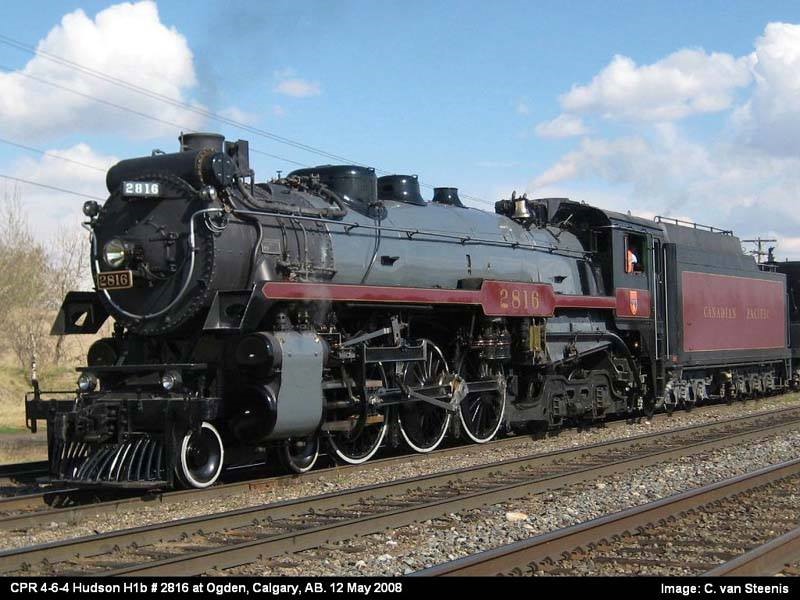
This event with "The Empress" will be an ideal vehicle to showcase the Canadian Pacific Railway's rich history in Canada, and the railways vital importance to the development, settlement, and industrial growth of our great country. We can all hope this historic event guides to fruition!
However, that exciting steam news was followed by a troubling comment we received. A CP source indicated this could be the final official company event for CPR #2816, and she could be sidelined for good. He mentioned following the event in 2017, the locomotive could be earmarked for donation to a railway museum, (or as CP has done of late, possibly put up for auction sale). However what CP will do with the "Empress" following the Canadian event in 2017 is unknown at present. We can hope … that where ever she goes, she will have a continued life in operation somewhere in Canada. (WB)
RCL IMPLEMENTATION:
One way CP is driving productivity and efficiency in rail yards is by adopting remote-controlled locomotives (RCL). A conductor operates an R/C equipped GP38-2 locomotive from the ground, to switch rail cars. Instead of relying on an engineer inside the cab, conductors and switch-crew members perform this work on the ground. CP is acquiring and implementing this technology. CP plans to spend $8 million this year to install remote controls on up to 52 locomotives involving 111 work assignments in their network. Then RCL implementation will continue in 2016.
CP have begun to reduce many yard jobs, with the goal to save $12 million per year, by implementing remote control operations now and continuing over the next year. Some of CP's main yards are already implementing the latest RCL operation, using their newest R/C modified GP38-2 fleet. The majority of these modified units are currently being done at Cadrail in Montreal, and also at NRE in Silvis, IL. Luc Lanthier shot one of them (CP 4440) at Cadrail in August.

CP IS EVOLVING, BUT VERY SLOWLY:
Since E. Hunter Harrison became CP's chief executive officer in mid-2012, he has strived to institute measures aimed at turning around what for years had been flagging financial and operational performance.
With assistance from his former CN right-hand man Keith Creel - who joined CP in early 2013 as president and chief operating officer - Harrison has guided efforts to reduce headcount, close nonessential hump yards, eliminate unneeded rolling stock, speed up and lengthen trains, shorten transit times, reassign assets and accelerate terminal throughput.
Some examples of that handiwork include the continued pursuit of a plan to trim about 4,500 employee and/or contractor positions by 2016 through job cuts and attrition (the workforce stood at 14,128 on June 30 versus 14,960 a year earlier); the realization of a goal in 2013 to reduce intermodal transit time between Toronto and Calgary, Alberta, by 20 hours; and the recent undertaking of an initiative to expand a dedicated train program for western Canada grain shippers.
Harrison and Creel have sought to craft and implement an operating plan they believe can prompt higher productivity, greater asset utilization and lower expenses in any business environment. The operating model they continue to refine is designed to help CP adjust or optimize assets, control costs, and drive earnings and income growth regardless of fluctuations in traffic demand, and their modeling essentially stayed true to form in the second quarter, when freight revenue slipped 2 percent to $1.6 billion (in Canadian dollars) and volume dipped 3 percent to 668,000 carloads. Despite that business downtick, CP logged its highest 2Q net income at $390 million and lowest 2Q operating ratio (OR) at 60.9 - which also now stands as its second-lowest quarterly ratio ever.
On a year-over-year basis, net income climbed 12 percent and the OR declined 4.2 points, while adjusted earnings jumped 16 percent to $2.45 per share, operating income increased 10 percent to $646 million and operating expenses decreased 8 percent to $1 billion. A sharpened focus on productivity and asset management also was apparent in 2Q service metrics, which vastly improved compared with second-quarter 2014 levels. Velocity climbed 21 percent to 21.7 mph, terminal dwell time shrank 22 percent to 6.7 hours, locomotive productivity improved 13 percent to 189 gross ton-miles per available horsepower, total train miles decreased 7 percent to 8.65 million and train lengths increased 3 percent to an average of 6,991 feet. "We moved trains faster, took out train miles and had fewer train starts, which lowered costs. Revenue was a little less in the quarter, but costs were a whole lot less," says Creel.
Even in the face of a slowing economy, the commitment to provide the best service at the lowest cost is serving CP well, and figures to continue doing so, said Harrison in a press release issued this summer. "The positive CP story is based on a business model that allows for flexibility - we are nimble, efficient and able to respond to the ever-changing economic climate," said Harrison, who as of late August expected to soon return to his top post after spending about four weeks recovering from leg surgery and a bout of pneumonia.
The push to refine operations remains a priority to keep the story in feel-good territory. Better operational performance will help ensure resources - from employees to locomotives to facilities - are in lockstep with business demand and CP is prepped to take on more traffic when volumes bounce back, Harrison and Creel believe. In addition, the Class I needs to reach a higher level of functionality to reach the following revised 2015 financial goals: revenue growth of 2 percent to 3 percent, an OR below 62 and adjusted earnings of $10 to $10.40 per share. "Rome wasn't built in a day. We're not going to change this culture in three years," said Creel during the July earnings conference. "We've converted a tremendous amount, but at the same time, this is a big network. From a productivity standpoint, there are still mountains of accomplishments left to achieve in this company."
CP so far has scaled a fair number of mountains. The railroad rid itself of most unwanted "fat" and revised service-performance levels - the typical first two stages a Harrison-led railroad goes through in a three-staged turnaround, says John Larkin, an analyst with Stifel Nicolaus & Co. Inc. Now, CP is in the midst of the third stage - increasing collaboration with customers to build traffic and drive double-digit revenue growth year in and year out - which typically takes much longer to pursue, he says.
"There is always fat in system, as with any railroad, and it took Harrison and Creel about three years to get 80 percent of the fat out. It will take five to 10 years to take out the other 20 percent," says Larkin. It's helped that Harrison has permeated a "no excuses" culture at CP that differs from the previous top management's propensity to chalk up poor operational and financial performance to various "disadvantages" besetting the railroad, he says. "They have unleashed the power that the previous administration didn't see," says Larkin of Harrison and Creel, citing sustained fluidity as an example.
Holding every employee accountable:
The culture also instills accountability for each employee, prompting every worker to think about his or her individual contribution to operations, says Ken Hoexter, an analyst with Bank of America Merrill Lynch Global Markets. "You talk to Hunter and Keith, and see they have a vision on how there is room to go. They have put in structural changes that show this is the way it's run," he says. That vision has helped push CP's service metrics to the head of the Class I pack, says Hoexter. "CP is the best in terms of improving velocity in the volume downturn. It's how to keep and win customers," he says.
CP's volume was "less worse" than the other Class Is in 2Q, when all railroads faced a very tough business environment, says Allison Landry, an analyst at Credit Suisse Group AG. CP has attained operating leverage for when volumes return and is in the best shape at current demand levels, a position gained from what Harrison and Creel already have accomplished, she says. "They have geared up the network, increased locomotive production and increased train lengths," says Landry. "They are also providing some faster service, and if they provide such service, then they get paid for it. That's Hunter's view of the world." Creel recently sought to gain his own view of CP's inner world when he paid an unexpected visit to a yard in Winnipeg, Manitoba, to observe and critique operations. He arrived on June 24 at 2 a.m. - a time yard managers and workers would least expect to be under observation, providing "a true reflection of how we're operating," says Creel. He first sat in his rental car with a radio and handset and monitored activity for about an hour. Creel then went to the tower and spent 16 hours talking with supervisors, asking a lot of questions while continuing to watch workers in action. He observed "a lot of good things that were done right," but also some tasks that weren't performed correctly, says Creel. "I'm proud to say I saw the best switch engine work I have ever seen at the company. The engine was ahead of the next switch and in the right position," he says.
Avoiding a false sense of security:
However, rather than switching cars, a switch crew was performing work outside their responsibilities - such as bleeding out air hoses on cars - that such highly paid crews shouldn't be doing, says Creel. Although supervisors said no carmen were available, "they need to set the tone" to direct people where they need to be and when, he says.
"The point is ask questions about why the crew is not doing the right job. Do what's right and not what you think is best," says Creel. "You think people are succeeding, but actually you're preventing people from succeeding."
The Winnipeg yard is one of more than 30 terminals in CP's network. After right-sizing the network, boosting train velocity and taking on other aspects of operations the past three years, 2015 has become "the year of the terminals" - as Harrison characterizes it - because those facilities are more complex and expensive to operate, says Creel. "We need to take a deep dive on terminals, where cost shows up and need to be driven out," he says.
More RCL:
Creel plans to continue visiting yards and riding on trains periodically to gauge the state of operations. "We can't say we've arrived, and we can't get complacent. It takes more work to get back to where we were," he says. "There can be a false sense of security about how operations are going."
One way to continue driving productivity and efficiency in yards is by adopting remote-controlled locomotives (RCL). A conductor operates an RCL from the ground to switch cars instead of relying on an engineer in the cab, conductors and switch-crew members to perform the work. CP is taking time to acquire and implement the technology says Creel. The Class I plans to spend $8 million this year to install remote controls on 51 or 52 locomotives involving 111 work assignments in the network, he says. The next round of RCL implementations would occur in 2016.
The technology will help reduce headcount demand for engineers, boost productivity and improve switching safety, says Creel. "The company had tried RCL in the past and we heard things like trains had broken down. They didn't really pursue it," he says. "It wasn't as productive or efficient as it could be. We want to change that." There's also a change in the works that targets asset management. CP plans to add more unit trains to a dedicated train program (DTP) for the 2015-16 crop year.
Introduced to western grain shippers in the 2014-15 crop year, the DTP is designed to generate velocity in the rail portion of the region's complex grain supply chain. About 70 percent of CP's grain operation is covered by the program, which enables shippers to determine the origin and destination, and manage the velocity of their supply chain.
For less-than-unit-train customers who don't qualify for the DTP, the Class I offers an open distribution program that allows shippers to order cars for four weeks in advance and place new orders as their car orders are filled.
In addition to generating operational gains from new or revamped rolling stock programs, CP aims to derive similar benefits by bolstering infrastructure. In 2015, the railroad plans to spend 21 percent of annual revenue on capital expenditures, the largest percentage among the Class Is, senior execs say.
To help increase network speed and efficiency, crews by year's end will lengthen or improve more than 30 sidings, and upgrade several yards, such as those in St. Paul, Minn., Calgary and Coquitlam, British Columbia. The infrastructure work also figures to help CP boost business in grain, intermodal, potash and other key sectors.
A goal-oriented railroad
All the operational improvement efforts in play company-wide should help CP hit its annual revenue growth target of $10 billion by 2018, senior execs believe. The Class I also aims to register a very-low 60s OR each year.
The railroad already has nailed a key performance target - and earlier than expected - which has helped drive operations, says Creel. Several years ago, CP set a goal of improving velocity 20 percent over a four-year period.
"So far this year, we've already achieved that goal and we're accelerating the operating performance," said Creel at the July earnings conference.
The higher average train speed has enabled CP to reduce the locomotive fleet more than 20 percent and trim headcount about 6 percent, while more resource-reduction opportunities lie ahead, he said.
"And we're gaining momentum in the third quarter," said Creel. "While we may have hit some unexpected business demands, macroeconomic headwinds in the short term of our multi-year plan, we're much further along from an operating point of view, which creates powerful leverage when business demand comes back."
(TRADE PRESS Jeff Stagl).
CANADIAN PACIFIC RAILWAY GETS AN "F"
(seekingalpha Newswire)
Summary
The employees at Canadian Pacific Railway have done an excellent job of turning the company from industry laggard to best in class.
Much of the turnaround can be attributed to the skill of Hunter Harrison and Keith Creel. These are executives who know how to run a railroad.
We admire the operational improvements at the company, but there's a difference between a good business and a good investment. For that reason, we rate Canadian Pacific as "avoid."
We've written about how investors have been rewarded for switching out of the expensive Class I railways diverging into the inexpensive shortlines. We offer an analysis of the most expensive Class I rail, Canadian Pacific, on its own merits. We believe that CP is operationally excellent and has probably the second best management in place of any of the rails. Though it is an excellent business, it's not an excellent investment at these prices and we must therefore caution investors from buying the company at these levels. There are much more attractive risk-reward relationships in the industry. Since investing in Class I rails is such a relative game, we'll start the analysis by comparing CP to its peers.
We'll note the following highlights from the table below:
At the moment, CP is 52% more expensive than the industry average on a PE basis and 54% more expensive on an EV/EBIT basis.
The industry average dividend yield is approximately twice that of CP.
ROA and ROE and Net Margin are all approximately 9% higher at CP than the industry average.
CP is slightly more highly levered than the industry average (debt:equity of .69 vs average of .66).
10-year, 5-year and 1-year revenue growth is lower at CP compared to the industry average.
One-year net income has grown 68% faster than the industry average.
CP SIDESWIPE DERAILMENT at Revelstoke, BC:
Canada's Transportation Safety Board has announced a full "Class 3" investigation into how two CP Rail freight trains crashed and derailed while one was trying to pass the other early Sunday high in the B.C. mountains just east of the Rogers Pass. A CP Rail conductor on eastbound train 602 suffered a concussion around 2:25 a.m. PT when he was thrown from his seat, while the engineer at the controls escaped serious physical injury when their locomotive, hauling empty potash cars, slammed into the tail end of a parked westbound train. The Transportation Safety Board of Canada deployed a team to the site of a collision and derailment. The TSB will gather information and assess the occurrence." Two locomotives, CP 9185, and UP 5528 both derailed when they sideswiped and collided with the tail end of train that had fully entered the passing siding.
The Main Points they are looking into:
CP train left without hand brakes above Revelstoke
Rail companies fight new rules to prevent crew fatigue
CP Rail lashes out at transport minister
The incident occurred at Beavermouth, along CP's Mountain Subdivision running between Golden and Revelstoke, BC. The Safety board examined 'over length' train and the signal aspects. Sources familiar with the incident said the parked, westbound train 113 was carryingdouble stacked intermodal freight cars and had pulled onto a siding and the train was over length, and too long to fit entirely on the side track and had several rail cars trailing out on the main track. On the approach to the siding at Beavermouth, several sources said, the eastbound train passed a signal indicating the crew should be prepared to stop ahead. But for some reason, the eastbound train rounded a corner, passed the first section of train 113 parked on the siding, and then failed to heed the stop signal in time and slammed into 113's back end.
Two front-end locomotives of train 602 derailed, along with an empty potash car. A single car of the parked westbound train was forced off the track. The length of the trains, and the communication between the crew and CP's rail traffic controllers, will be central in the investigation.
"Because we have two trains operating on the same track, obviously we are going to look at the procedures and safety defences in place to see if there's any breakdowns there," the Transportation Safety Board's Krepski said. "Length of the train,... whether the train was the appropriate length for the siding." "Over-length" trains are not uncommon on CP Rail's main east-west corridor. Oncoming trains are able to pass one another if the shorter train stops adjacent to a siding, to allow the longer train to then snake around using the side track as a passing lane.
But in 2009, CP Rail suffered a similar side collision of two trains involving one which was over-length. It happened at Redgrave, just eight kilometres east of Sunday's crash site. In that case, the safety board concluded the crew of the oncoming train was distracted, failed to appreciate the train ahead was "over-length" and partially blocking the main track, and ultimately failed to heed the signal warning them to stop.
The safety board interviewed the crew of CP train 602 on Sunday and will begin downloading and deciphering the locomotive event recorder to determine how fast the train was travelling when it first applied its brakes. The results of the investigation are not expected for many months.
This Transportation Safety Board photo shows derailed locomotives CP 9185 and UP 5528 following the Sept. 6. 2015 collision between Revelstoke, and Golden, BC.
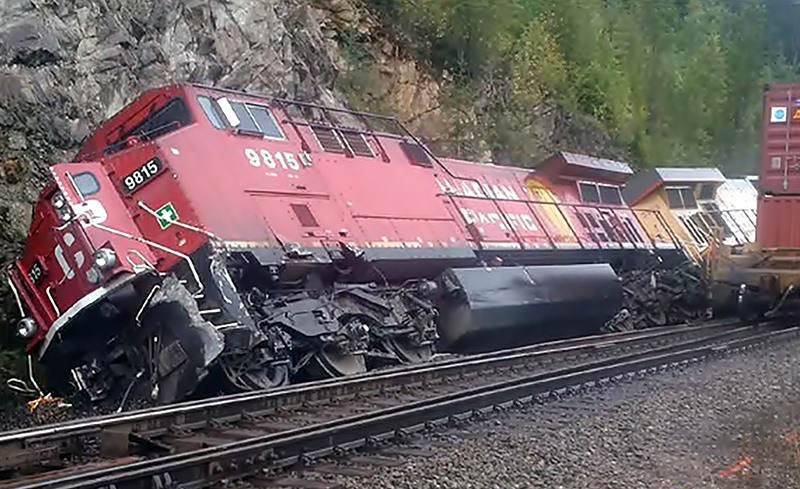
Update on this incident:
Transportation Safety board spokesperson Chris Krepski said the incident happened at 2:25 a.m. Pacific Standard Time at Mile 62 of the Mountain Subdivision when an eastbound train struck the tail end of a westbound train that was on a siding. Krepski said that the two head-end locomotives and the first car on the eastbound train derailed, as did the last car on the westbound train. "Everything derailed upright and there were no reports of injuries or leaks," Krepski said. The derailed car on the eastbound train was an empty potash car, while the derailed car on the westbound train was a "loaded non-dangerous goods car." Krepski said their investigator was arriving on scene mid-morning and the information he was providing to the media was reported to the TSB by CP Rail. CP spokesperson Jeremy Berry confirmed the bare basics of the event, saying there were no injuries or public safety issues. The TSB is now investigating the incident, gathering information on things such as the condition of the rolling stock, ambient weather conditions, interviews with witnesses, retrieving data loggers from the trains, and conditions of the tracks. TSB reports typically take many months before they are posted to the TSB website. Krepski said the investigation on the ground will in part determine whether this incident results in a report to the public. "We'll have to assess the information that we gather from the incident site and determine what the next steps will be," he said.
CP 83 LACOMBE at STETTLER, AB:
CP No. 83, Business Car "LACOMBE", was the only CPR Business Car for which Cor van Steenis did not have any close-up photos; only a few images from a great distance through a fence while it was stored at Ogden Yard. So when Earl Roberts (Canadian Trackside Guide) told me that the car had been leased to the Alberta Prairie Railway, a trip to Big Valley and Stettler was in order. Yesterday, 06 Sep 2015, we caught the car sitting on a spur at Stettler, AB., just north of the P&H grain elevator, on Alberta Prairie's tracks. The car needs a significant amount of work as can be seen in he photos; the APR staff told me that they would be refurbishing the car and using it on their excursion runs from Stettler to Big Valley. They said the car would not be painted in the green and black APR livery but would retain its CPR Tuscan red livery with gold lettering. Will be worth another trip when it is restored! (Cor van Steenis)
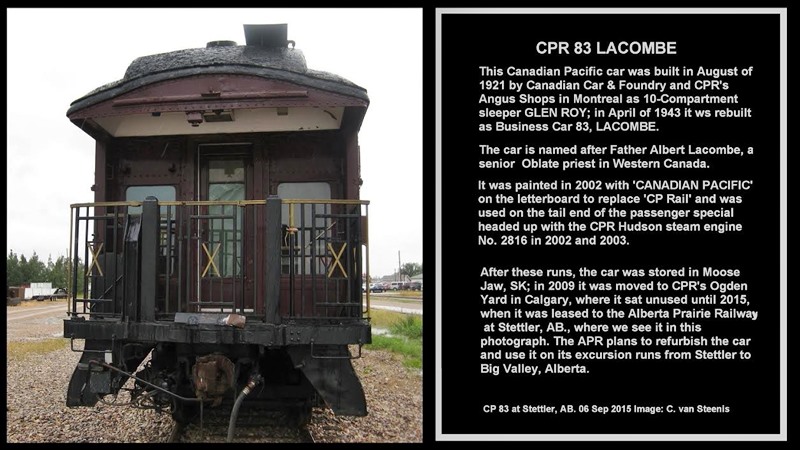
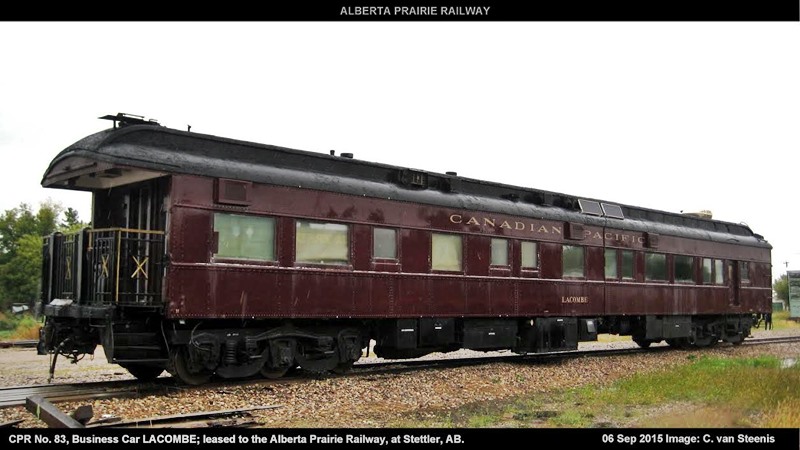
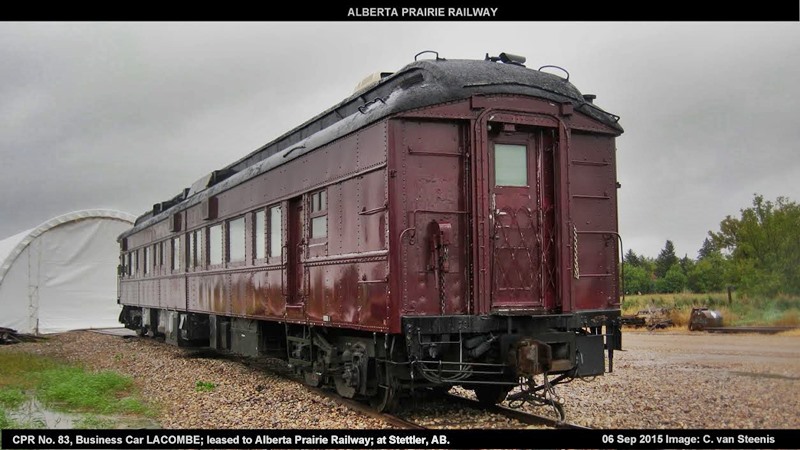
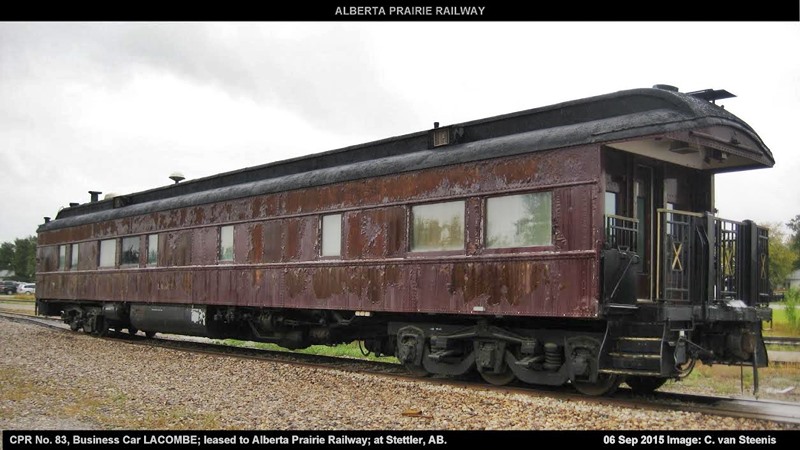
ST-LUC DIESEL SHOP:
I dug up this great shot from a fond memory many years ago. I was invited by Shop Forman Giulio Capuano to the St. Luc Diesel Shop on December 23rd, 1993 to witness the final MLW BIG M series to be retired. The employees had three of the series on display for the event: CP C630M 4500, M636 4716, and CP M636 4706, which would be the final one to be retired "Live". CP president Rob Ritchie arrived in a Buick Century from downtown to shut down #4706 for the final time (via the fuel stop button above the tank). Photo Ross harrison
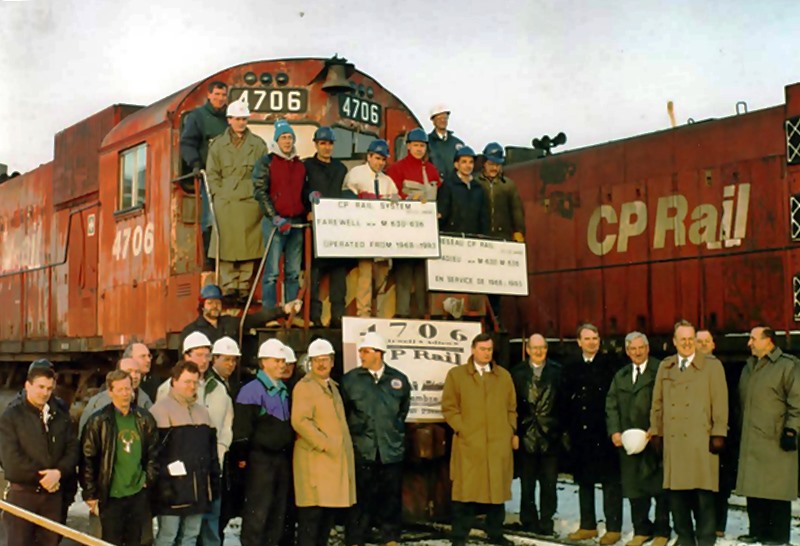
However, has luck would have it, in a severe power shortage months later, several of the units were reactivated for several months in the spring until they were finally re-retired due to their many ailments. The CP official photographer is the fellow with the camera on the left rushing to get the same and stand next to me. Shooting that dau with me was Richard Young, Ross Harrison and other well known Canadian railfans who I would not know the names of until I would create "CRO" a year later!
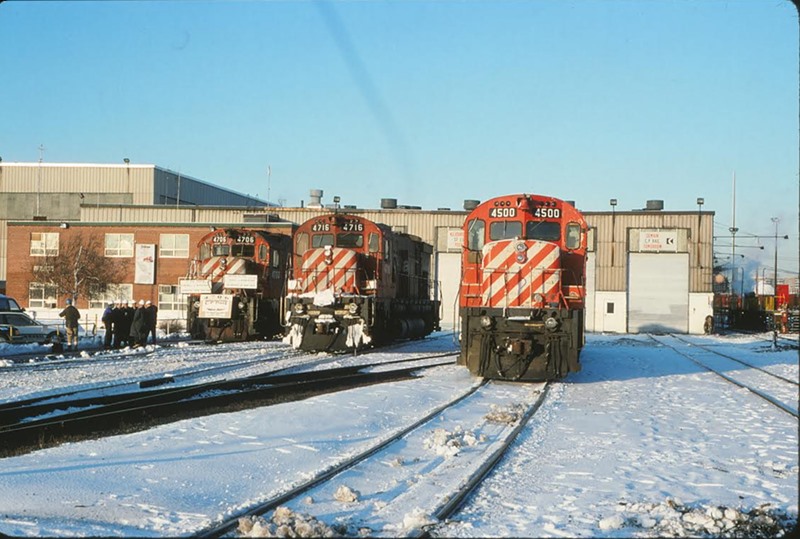
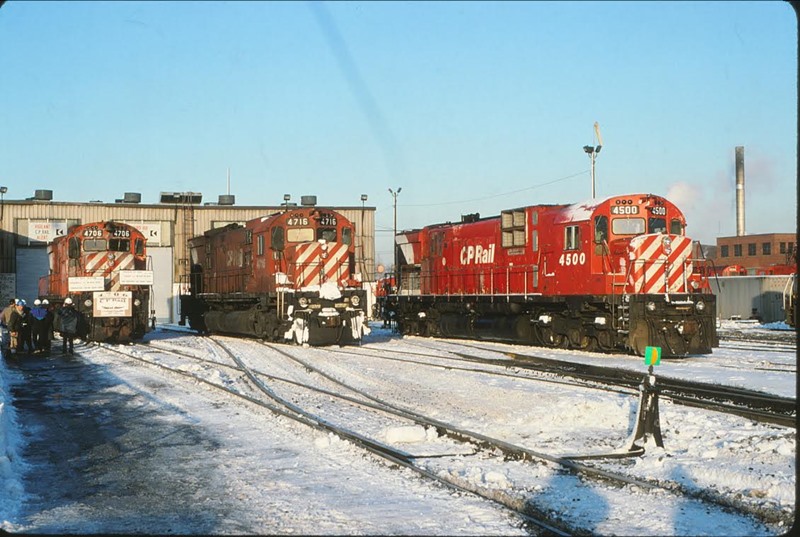
CP AGINCOURT YARD:
CP has are selling the A and B yards at Toronto Agincourt Yard. Also the Havelock Sub will likely be sold to Metrolinx. Metrolinx has a $750M yard and maintenance facility under construction on the north side of the Kingston /GO Subdivision at Whitby. They have also consistently said that anything that might involve the North Toronto Sub or service east on the Havelock and Belleville Subs is in the future, coming a very distant second to projects that will beef up its existing routes. The folks in Oshawa think they're soon going to see GO service to the old Knob Hill Farms site, but that, too, is a long way off down the track.' ‘On the other hand, today's CPR is looking to squeeze every cent out of its assets. Most of Toronto Yard is now redundant. Obico Yard is shuttered and up for sale. Strips of land on the north side of west Toronto/Lambton Yard have already been sold or leased. CP is wanting to unload all of its surplus real; estate quickly and for top dollar.' ‘Unless Metrolinx or the City of Toronto (which has been sniffing around Toronto Yard recently) have deep pockets, I see them getting shoved aside in favour of more lucrative commercial redevelopment.'
CP has ripped out the 72 tacks that comprised C Yard; everything south of that is still active. Combined with the A and B receiving and departure yards to the north, that's a very large piece of land for possible redevelopment, provided it can be remediated at a reasonable cost. CP investigated the sale of the entire property and relocation to alternate facilities back in the 1990's. They had a buyer, who walked away becauseof the enormous cost of cleaning up the site.'
FORMER CP STATION:
On September 17th, the historic railway station in Beiseker, AB was destroyed by fire overnight. A century-old train station that was planned to be the centrepiece of a railway museum northeast of Calgary went up in flames overnight. And investigators are working to determine whether the blaze was deliberately set. Firefighters were called after midnight Friday to the railway station in the village of Beiseker to respond to a blaze. When they arrived, they found the 104-year-old building engulfed in flames. Fire crews managed to douse the fire, "but the south half of the building is burned right to the ground," said Fred Walters, treasurer of the Alberta 2005 Centennial Railway Museum Society, which was working to restore the station. "Talking to insurance adjusters, they say it's got to come down," Walters said. "I don't think the insurance company is going to allow us to salvage it because of the amount of water damage inside the building." Sgt. Glen Demmon with the Beiseker RCMP said the cause remains under investigation but the fire is believed to be suspicious. "There's no power to the building," Demmon added. Walters said the board members will have to discuss where they go from here. Mayor Ray Courtman said the building was vacant at the time and no other buildings were damaged or destroyed. "It's quite unfortunate," Courtman said. "We were kind of excited about this project." (The Calgary Herald)
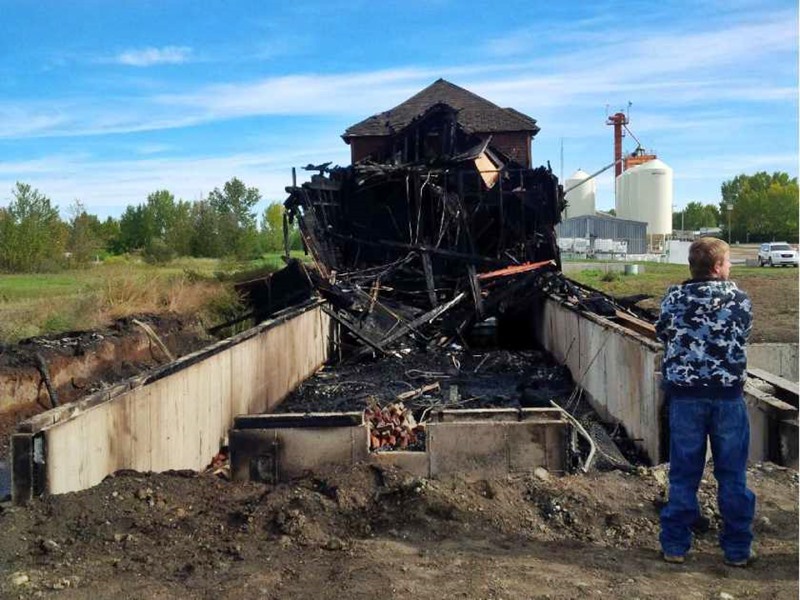
THE LAST ONE! SOO LINE 2010, nee Milwaukee Road 190, is the last bandit still on duty for CP/SOO. She can usually be found near the Twin Cities, MN, or in the LaCrosse, Wisconsin region. Here are two recent shots by Al Jareau, and Dennis Weber. Roll on, Milwaukee Road! -
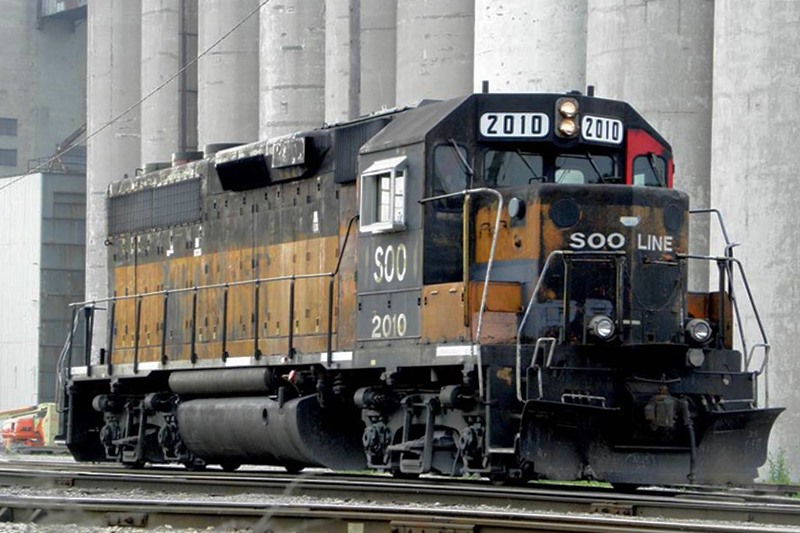
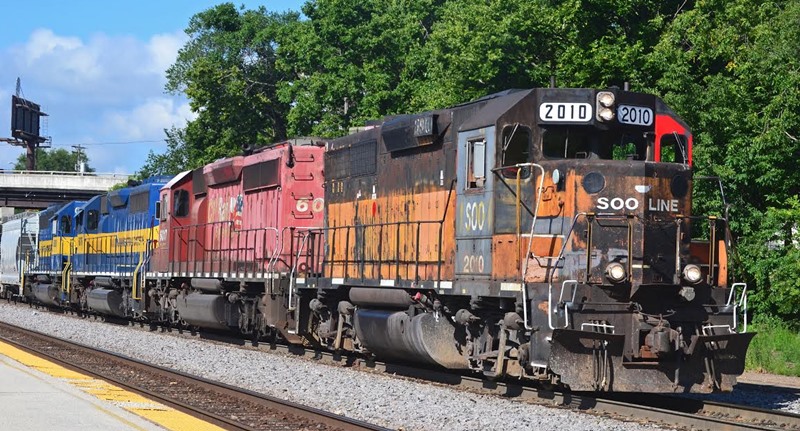
Luc Lanthier shot CP 2316-2240 at Exshaw, AB switching the Lafarge plant on September 18th.
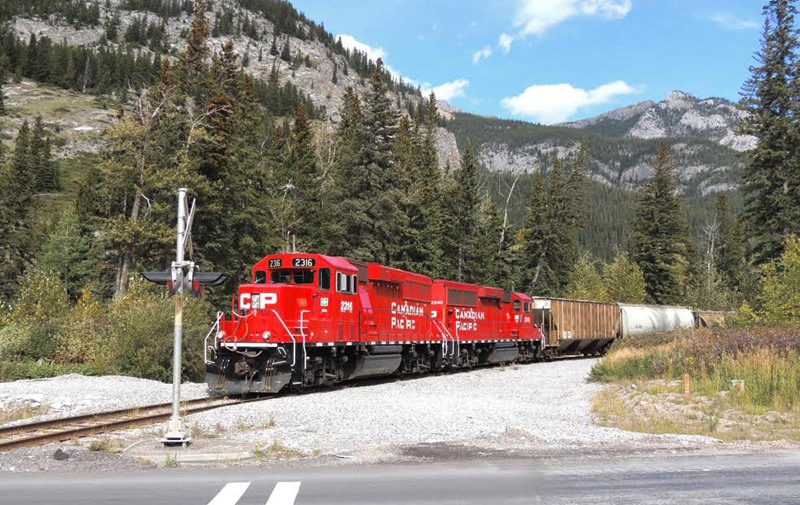
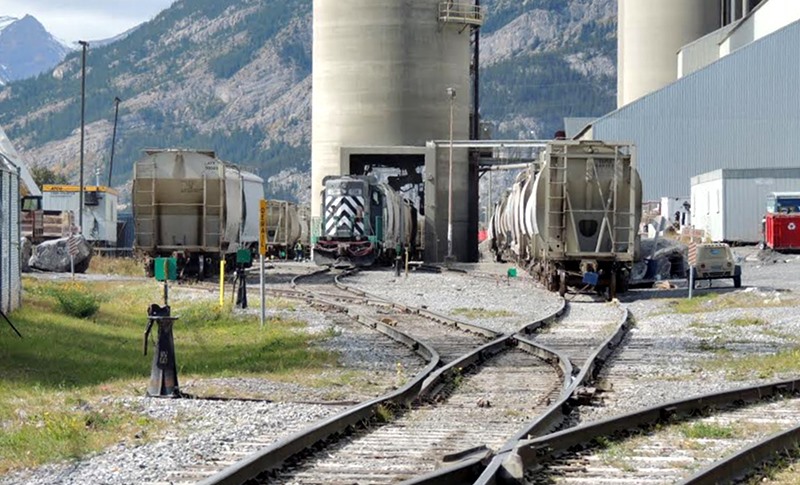
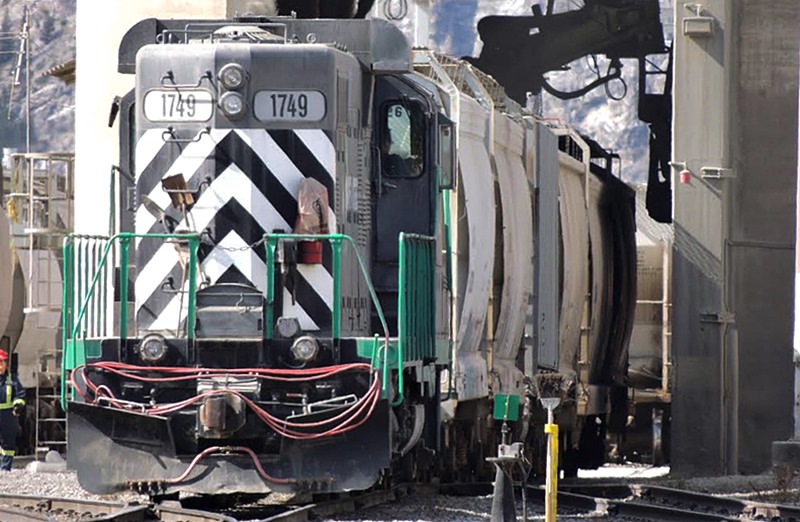
Raymond T Bozek shot CP GP20C-ECO 2279 displayed at Steamtown in Scranton, PA for Railfest in August, with the NS SD60E 911 Honoring First Responders Loco.
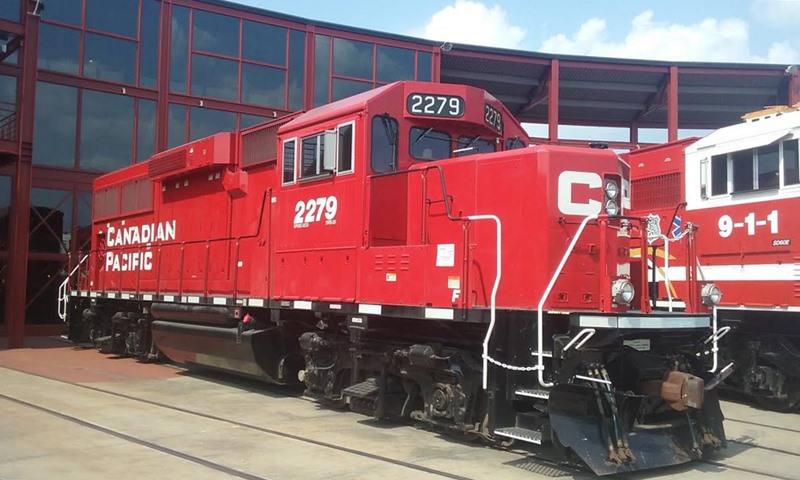
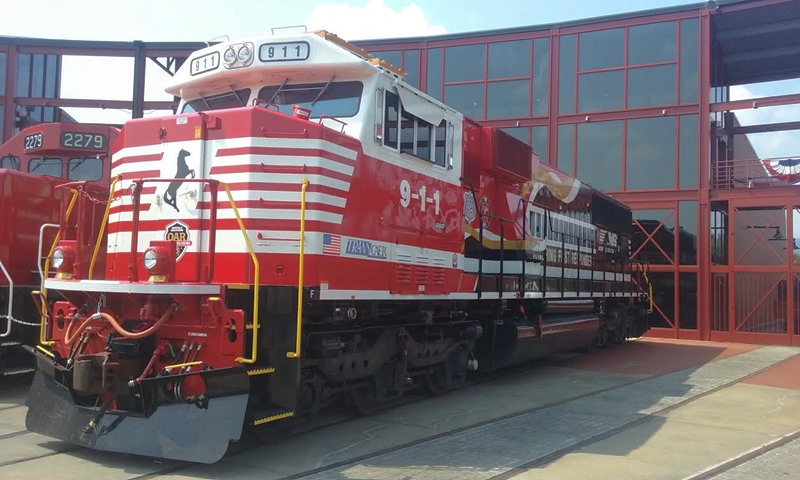
CP 602 MEETS 603, FIELD, BC: While waiting for the Canadian Pacific Business Train 32B-24 to depart Field on 25 Aug 2015 we caught two potash trains, CP 602 EAST (empty), and CP 603 WEST (loads) meeting at the east road crossing at Field, B.C. The meet, with each freight train changing crews, had to be completed before the business train could depart Field station as it was on a yard track sandwiched between the two passing potash trains.
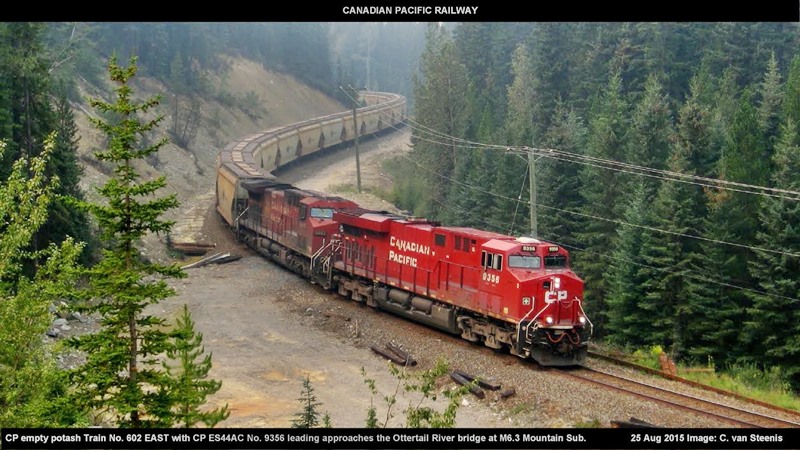
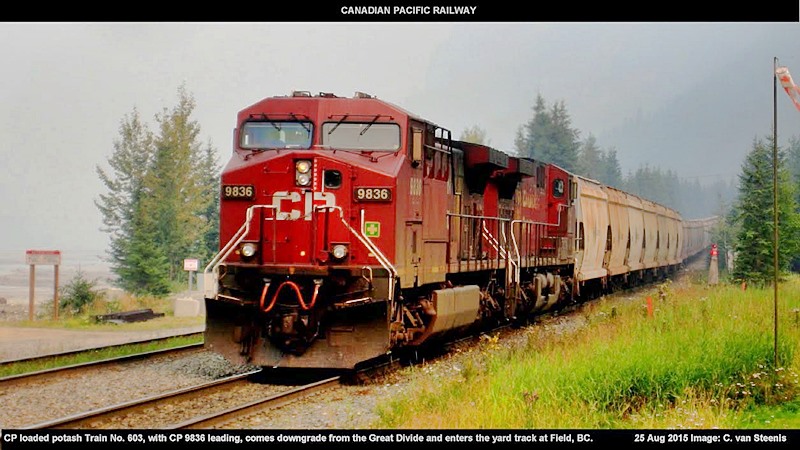
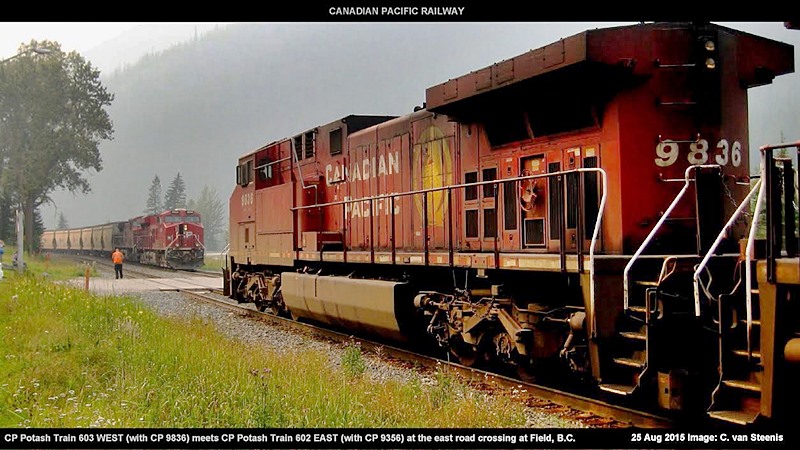

On September 22nd, Dennis Weber caught CP 280 with matching KCS-3937-4125, at Dakota, MN.
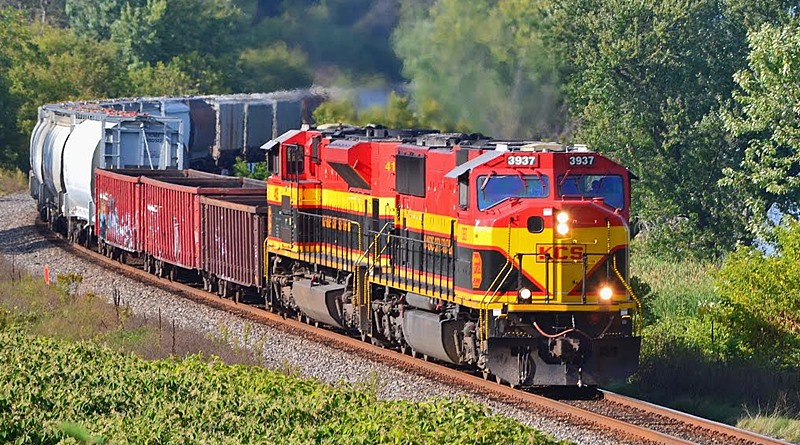
OLD SCHOOL LEADERS! Dennis clicked the following two shots of second generation motive power still soldiering on! The CP "Road Switcher" has SOO 4413 and SOO 2010 in Milwaukee Road patched Bandit livery. LaCrosse,WI, on August 30th, 2015.
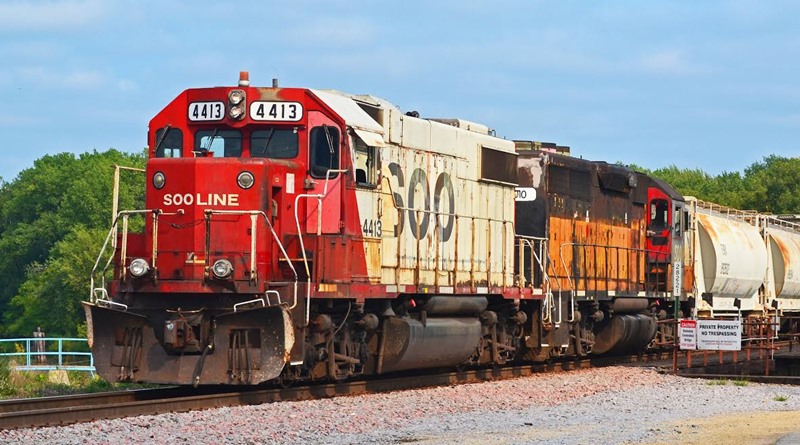
Denis clicked CP H-20, with CP SD40-2 6080, and CP SD60 6259 at LaCrosse, WI, on August 30th, 2015.
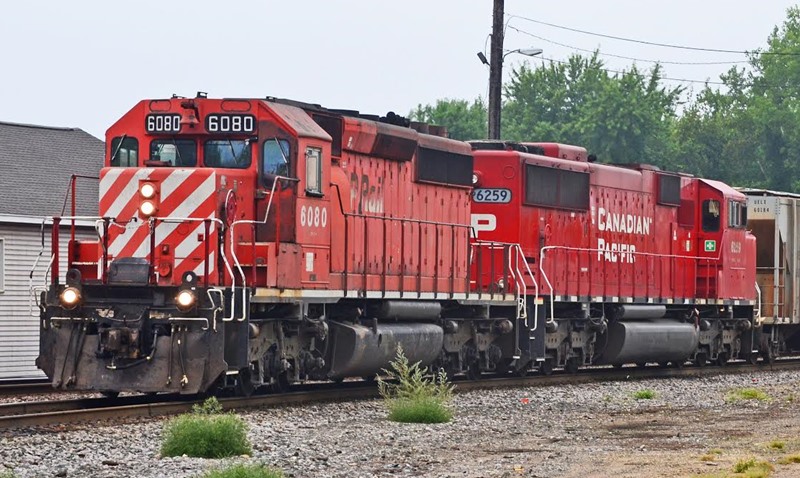
CP Road Switcher (RS8) By Andy Cassidy: This location is in a new riparian area amongst a mass of overpasses that make up the new Cape Horn Interchange. It takes knowledge of the area to get here, but as with any of these spots it will soon be a lost venue due to growing vegetation. Mind you, the hot weather this year will probably have killed off a lot of it so I might be able to get shots from here for a bit yet. The signal shed in the first shot can be accessed easily from United Boulevard across from the Casino, but I can't get to it from my location as a watercourse divides the area. In any event, on March 23rd, 2015. I was able to catch CP Road Switcher (RS8), bringing home a parked grain empty that had been dropped off earlier along the Fraser Mills strip (Sapperton). I'm a tad north of Mile 3.6 on the CP Westminster Sub at Booth. Everything you see in the photos up to 013 is new terrain. Even the rail alignments south of the signal were changed here when they started the highway project back in 2009. In the first photo you see a gravel road to the left of the ROW by the green patch. Currently it's not a bad spot for getting shots on the curve there, which I have done a number of times. It's also a spot where the crews are frequently taxied to and from when East/North bound bulk empties are parked there, having unloaded their cargo in North Vancouver. How long that spot will be good for photos is undetermined. I'm fully expecting a fence will soon be erected to separate the railway ROW from the municipal land there. CP 4447-4400 (EMD GP38-2's), leads the CP 8723 (GE ES44AC). They have the GE doing all the work on the way towards the CP Coquitlam Yard.
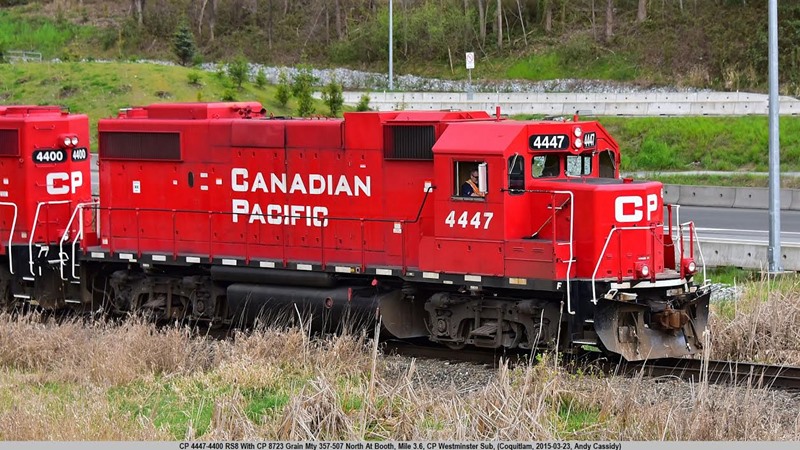
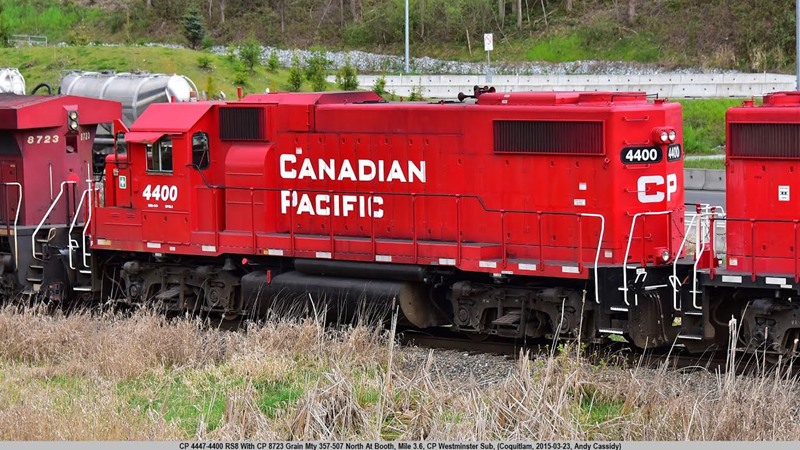
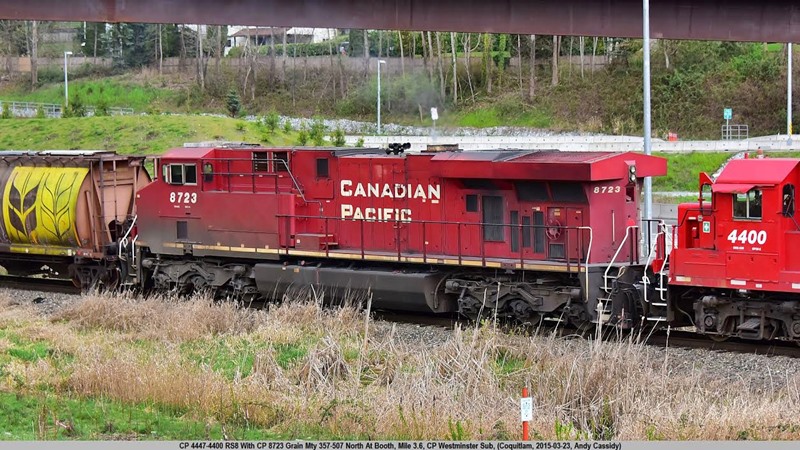
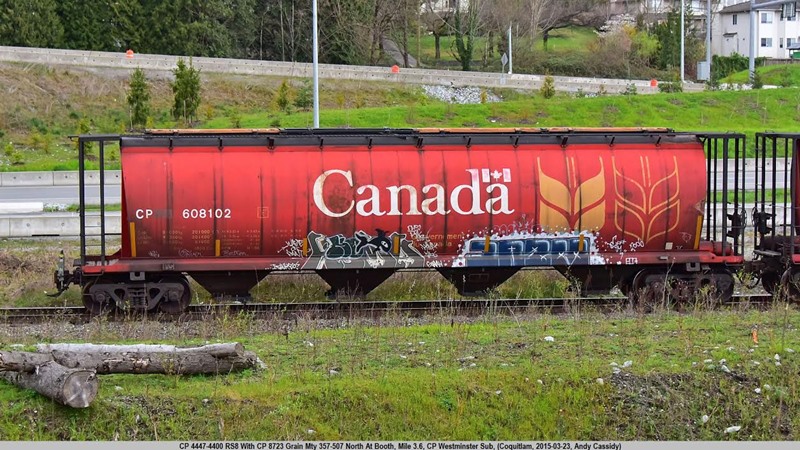
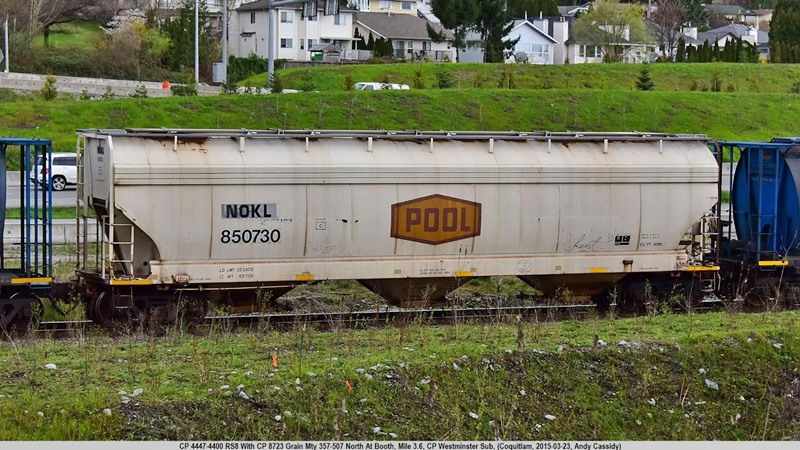
CP train 298 was awash in Armor Yellow with two UP units (4363-4251) as it passed through Dakota, MN on September 6th.
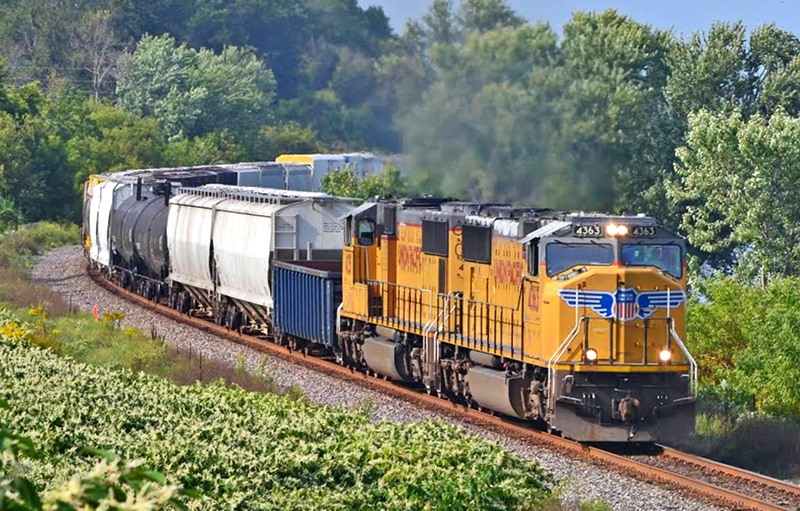
Denis Weber clicked CP 471, with CP 6242, and NS 2733, Bangor, WI on August 27th,.
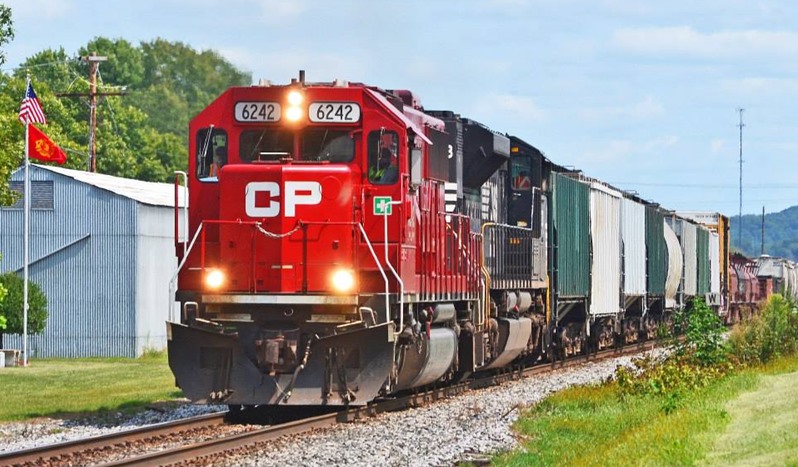
CP GE's continue to pay Horse-Power-Hours (HPH) to BNSF and UP as can be seen in the following shots:
Amtrak Cascades train 507 is leaving the station with the 468 pushing, just as a UP Canadian grain train arrives with the UP 5540 and CP 8907. The DPU was CP 9737. The UP 5540 will stop at the switch, where a BNSF yard crew will board unit and take it to the Port of Vancouver. (Shawn Heller photo).
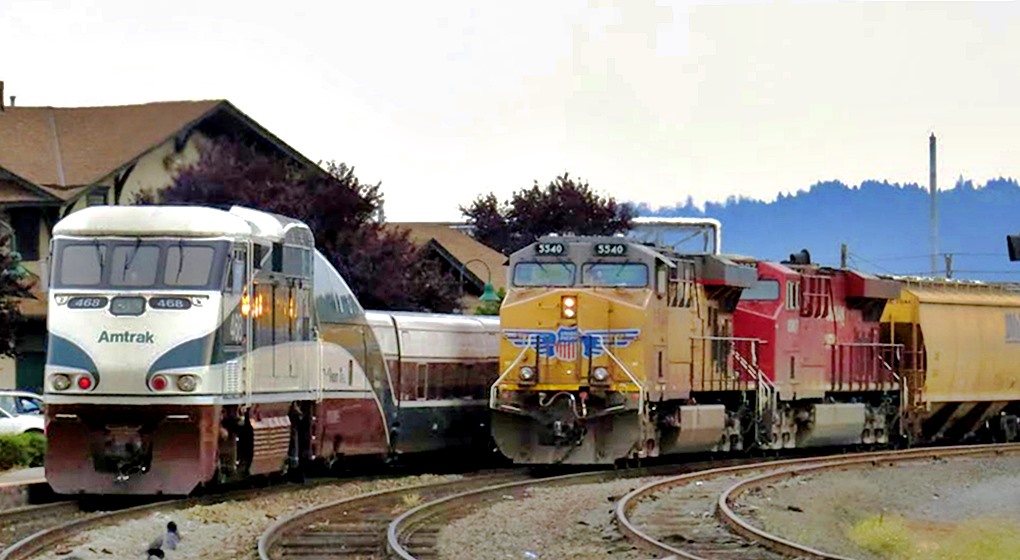
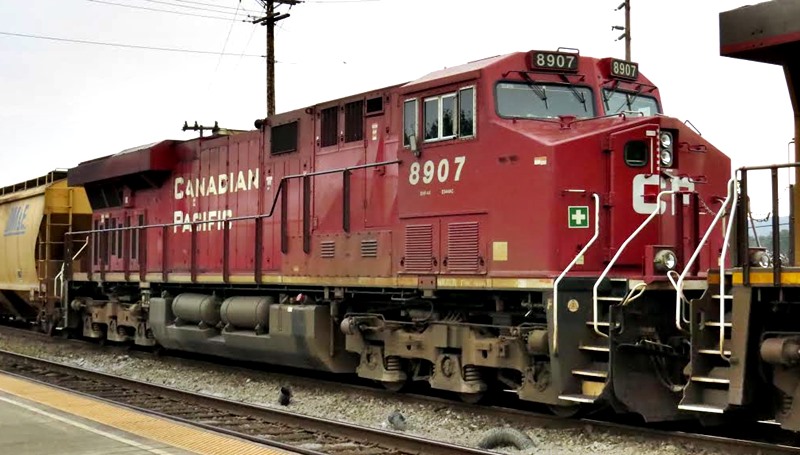
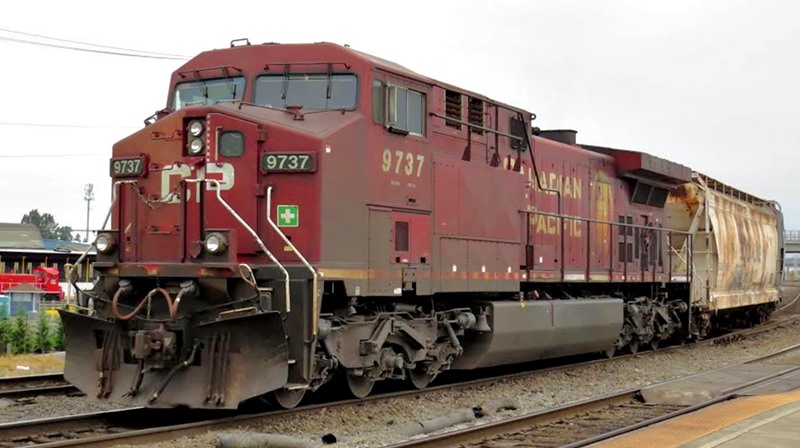
AMTRAK Train #11 with Amtk 505 Amtk 168 and 11 cars at Rodeo, CA ...You don't see many GE 500's on the point on the west coast trains very often (Shawn Heller photo).
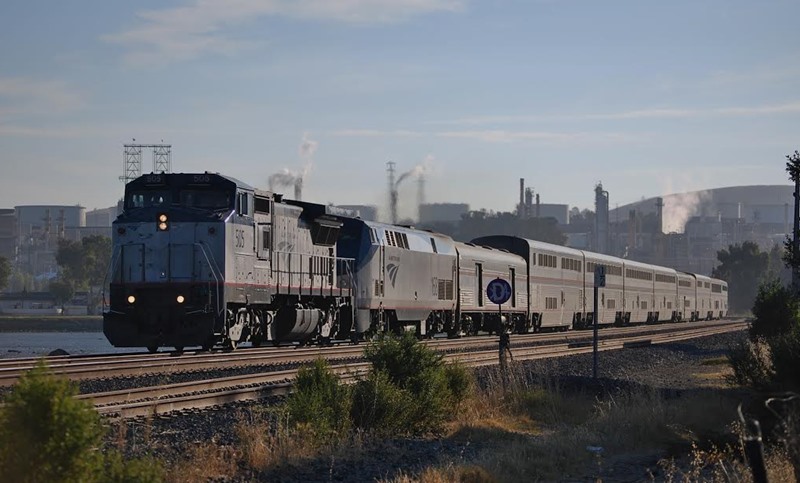
UP SB oil train lead by UP 8103, CP 8710, and CP 8761 was clicked by George Manley at Stockton, CA in September.
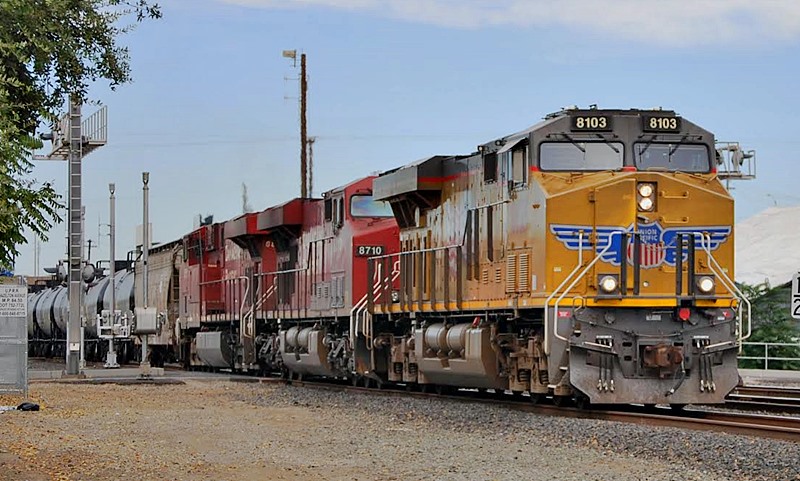
CP 9351 working as the DPU on the SB oil train is crossing the BNSF diamond at Stockton, CA.
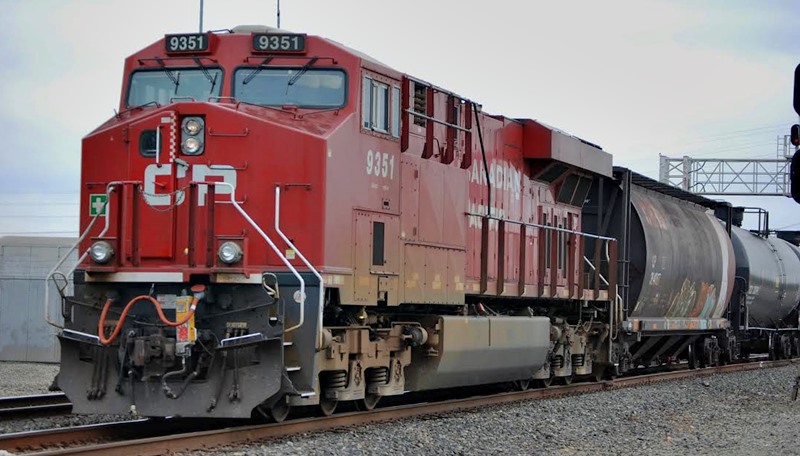
Walter Pfefferle snapped CP DPU'd oil train rolling through Zorra Ontario September 5th with CP 9725 as the leader, and CP 8871 bringing up the rear.
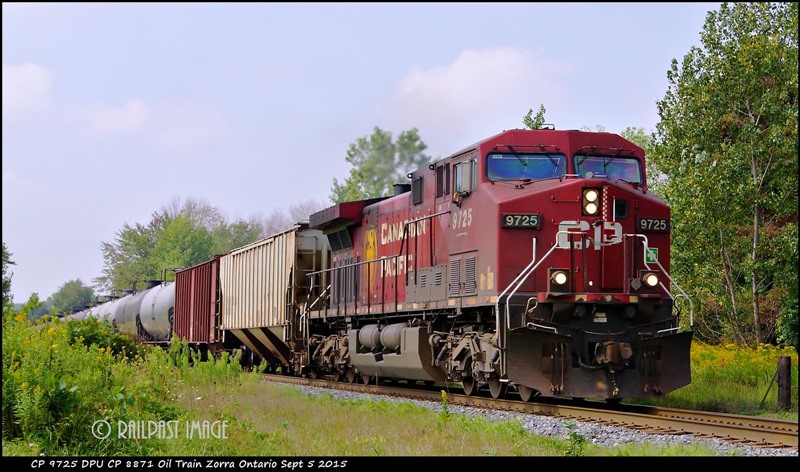
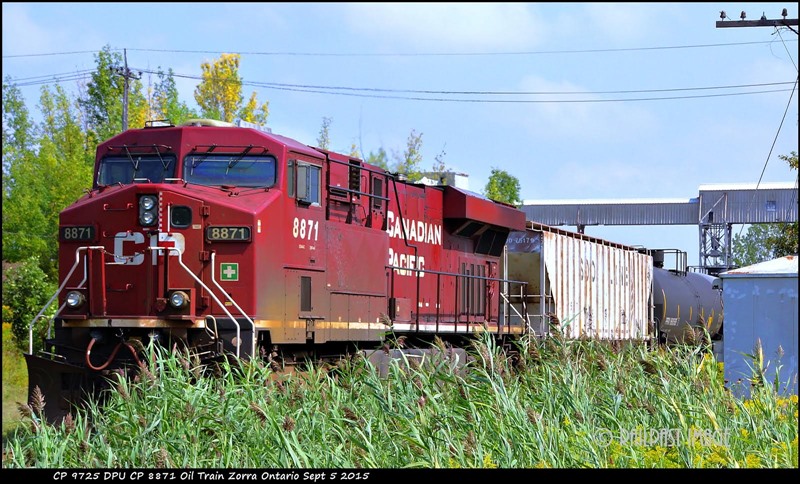
On September 8th, Ron Visockis clicked CP 9352 and CP 8798 E-B at Belleville, ON.
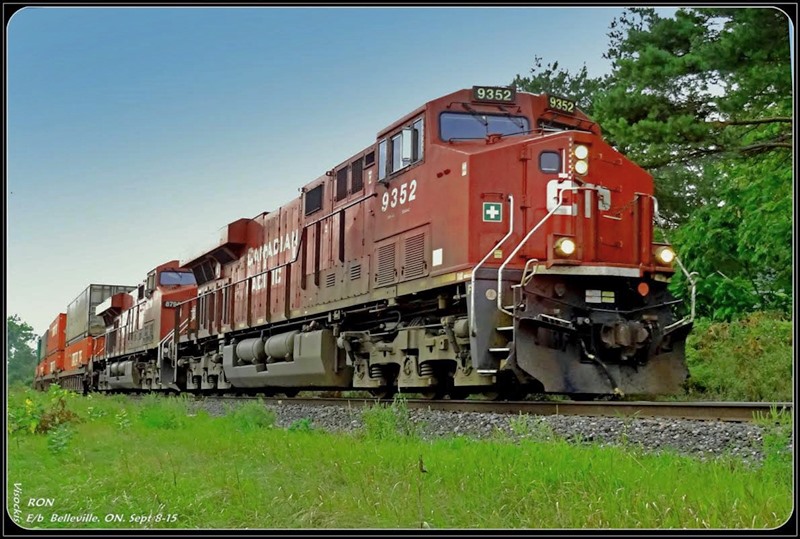

CP VIGNETTES
Sponsored by Old Time Trains

James A. Brown clicked CPR Extra 999 steaming on a Westbound between Donlands and Leaside, ON on February 11th, 1959. See also similar view with the "Empress of Agincourt" CP 8921 at the same location, years later.
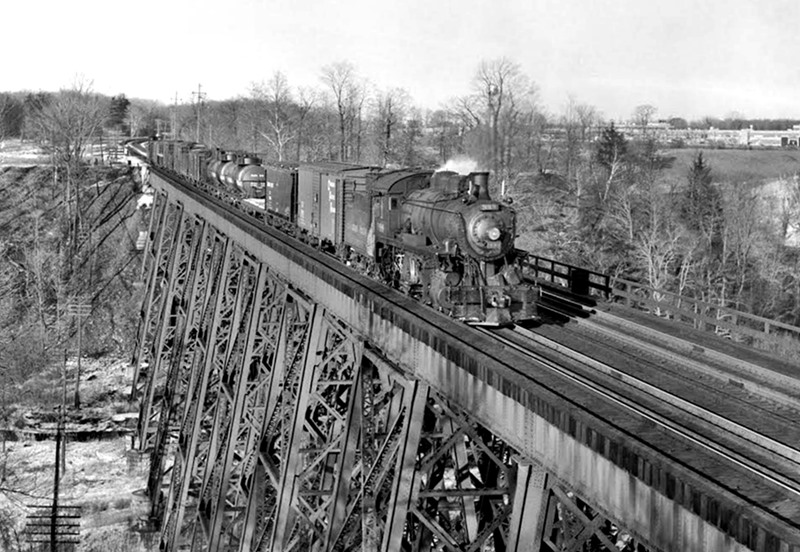
CPR RSD17 8921 with the Transfer westbound at Mile 205.18 of the Belleville Sub, seen on the CP bridge just east of Leaside. This photo was taken Friday, June 18th, 1971 by David M. More.
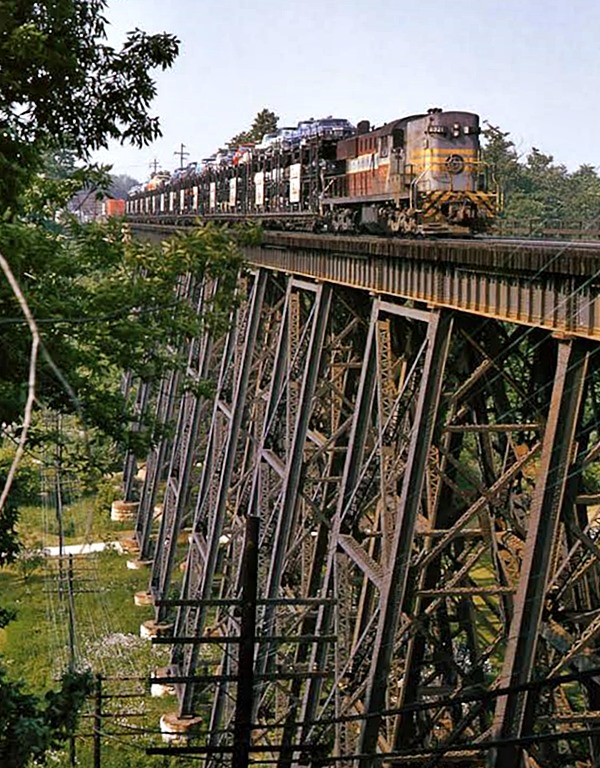
Phil Mason sent these interesting front and tail end shots of the "Atlantic Limited". The photo focus is a bit soft, but it was taken with a point and shoot Konica. CP train 41 is just west of Delson, QC with a pair of RS-10's on March 1st, 1969 with just a single coach, sleeper and a "Skyline" dome serving as the diner. Three business cars are on the tail end: The first heavyweight is an R-series sleeper, still regularly assigned to this train until later in 1969. The second looks at first glance like a heavyweight diner, but turns out to be business car Metapedia, which was actually rebuilt from a wooden diner and later steel sheathed, retaining the original dining car windows. Like many sheathed cars the sides are sagging a little, even with a steel underframe added. The last car is business car is Assiniboine. (with thanks to Don Thomas of CP for info on the tail end cars!)
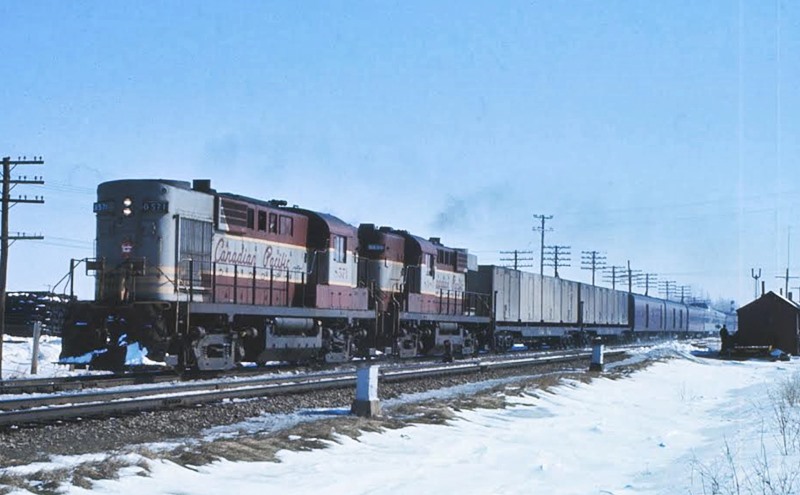
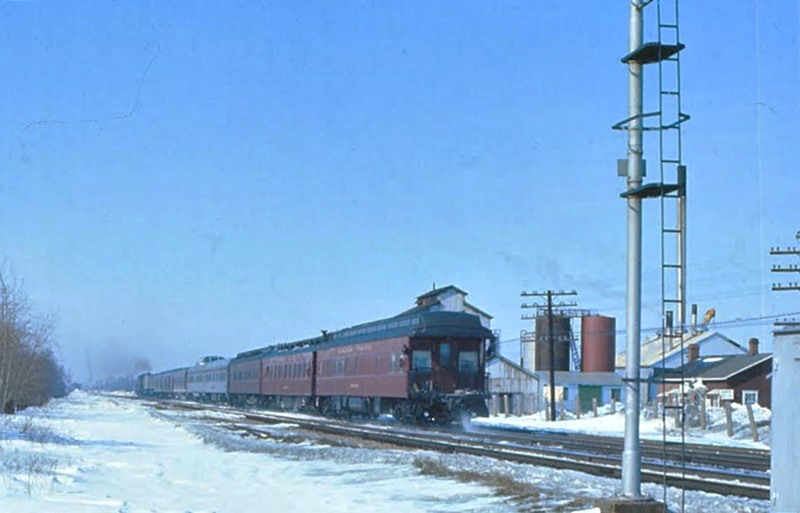
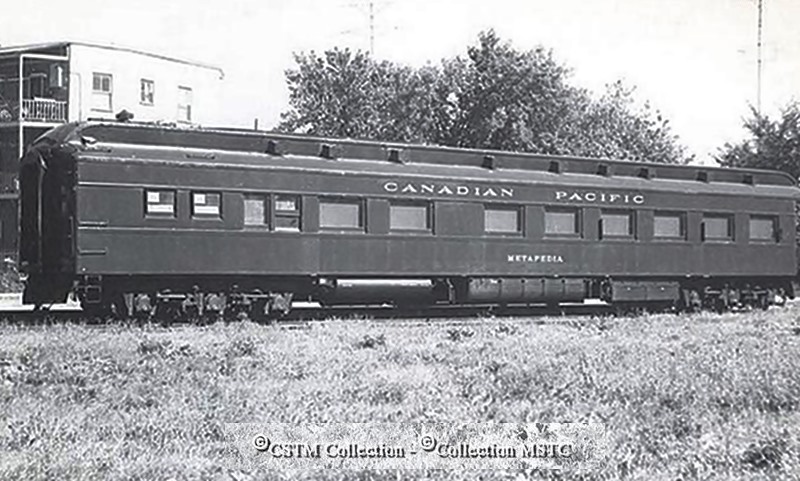
CP Caboose on the tail end of pulp wood cars, as they depart Magog, QC in 1962.

CP RAIL M630 4569, at the D&H's East Binghamton yard back in May 1992. It was getting late for the six axle M liners by this time and they retired not long after this photo. I miss these Big M's so much ... Even with the "orange peel" appearance!
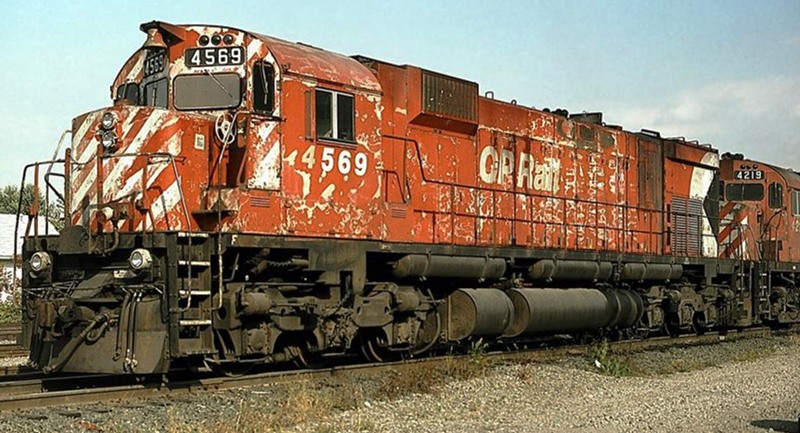
CN OR CP? On May 17th, 1985, David Brook photographed CN's contribution to promote the "EXPO ‘86" World's Fair in Vancouver, BC. Wearing candy stripes, CN SD40-2W 5334 certainly stands out awaiting its next assignment in MacMillan Yard. For comparison, here is one of the CP Rail Expo '86 painted SD40-2's just below.
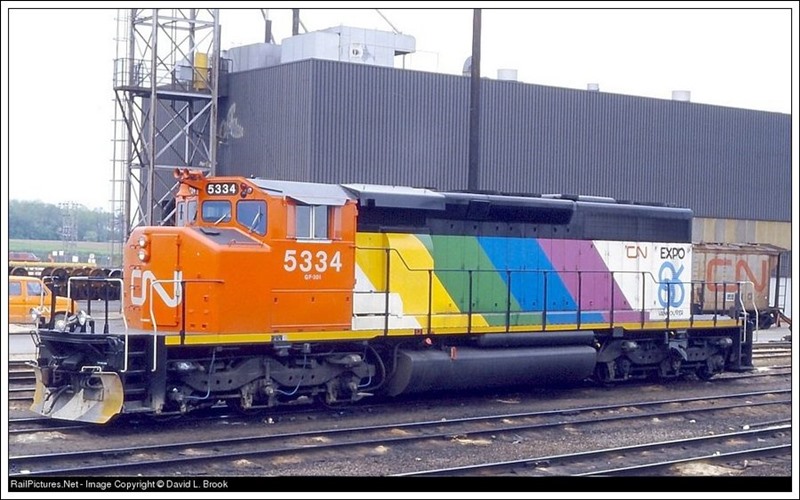

During the 2010 Olympic Games in Vancouver, Canada, a special was run over the BNSF in Vancouver and Washington with former CPR 4-6-4 ROYAL HUDSON #2860, with BNSF backup. Mark Forseille shot the train steaming through New Westminster, BC on Canadian BNSf trackage in 2010.
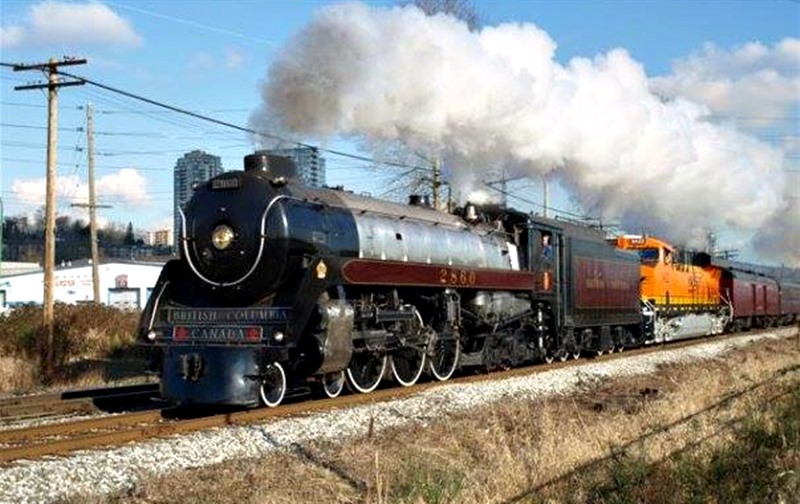
© CRO October 2015

